Learning and Development: Ownership Structures and L&D Policies
VerifiedAdded on 2023/05/29
|26
|7482
|195
AI Summary
This article discusses the ownership structures of businesses, including sole traders, limited organizations, and business partnerships. It also explores how L&D policies can assist organizations in achieving their objectives and the process of developing an L&D policy. The purpose of the L&D policy is to address the rapidly changing environment of operation and manage the business effectively.
Contribute Materials
Your contribution can guide someone’s learning journey. Share your
documents today.
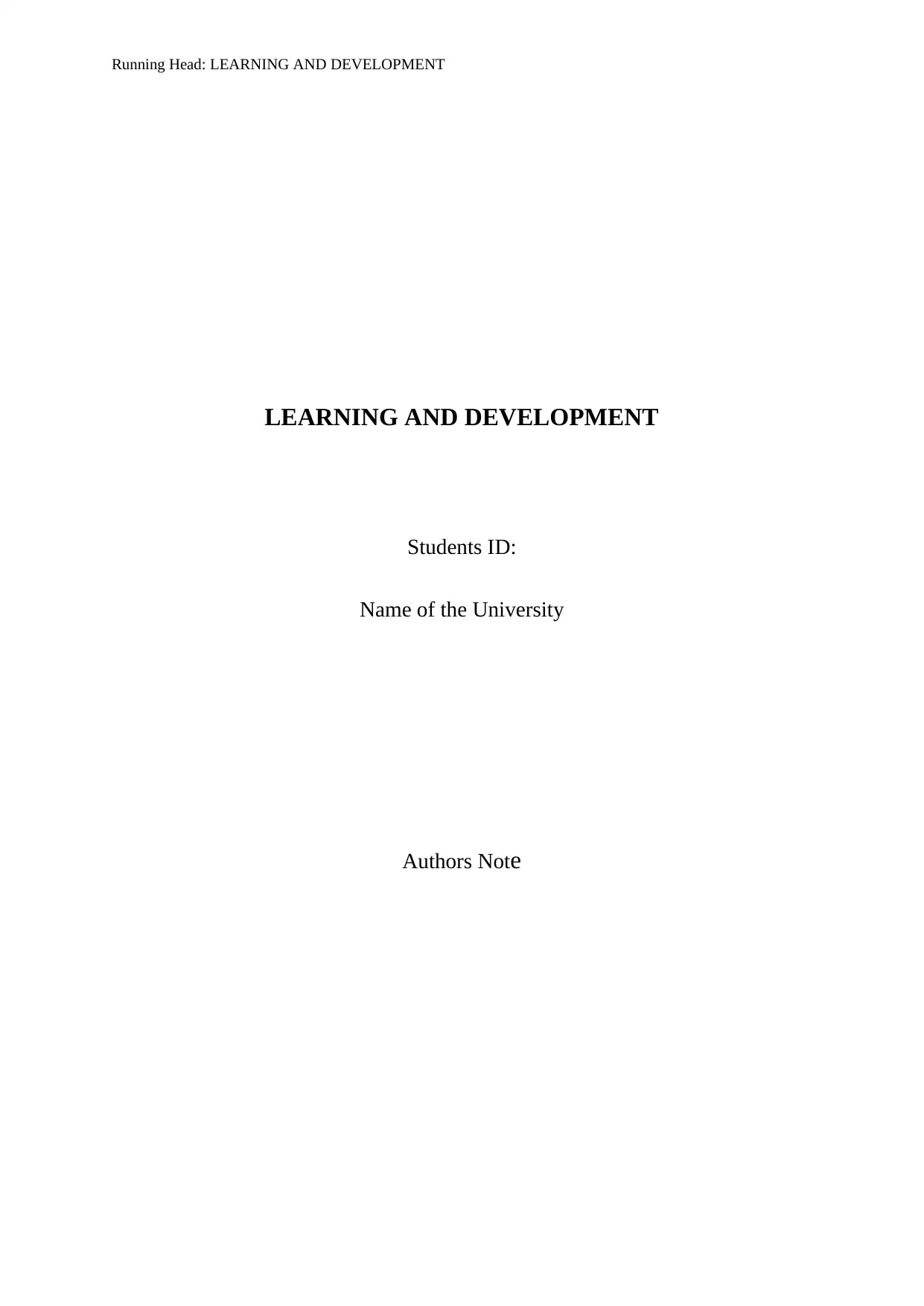
Running Head: LEARNING AND DEVELOPMENT
LEARNING AND DEVELOPMENT
Students ID:
Name of the University
Authors Note
LEARNING AND DEVELOPMENT
Students ID:
Name of the University
Authors Note
Secure Best Marks with AI Grader
Need help grading? Try our AI Grader for instant feedback on your assignments.
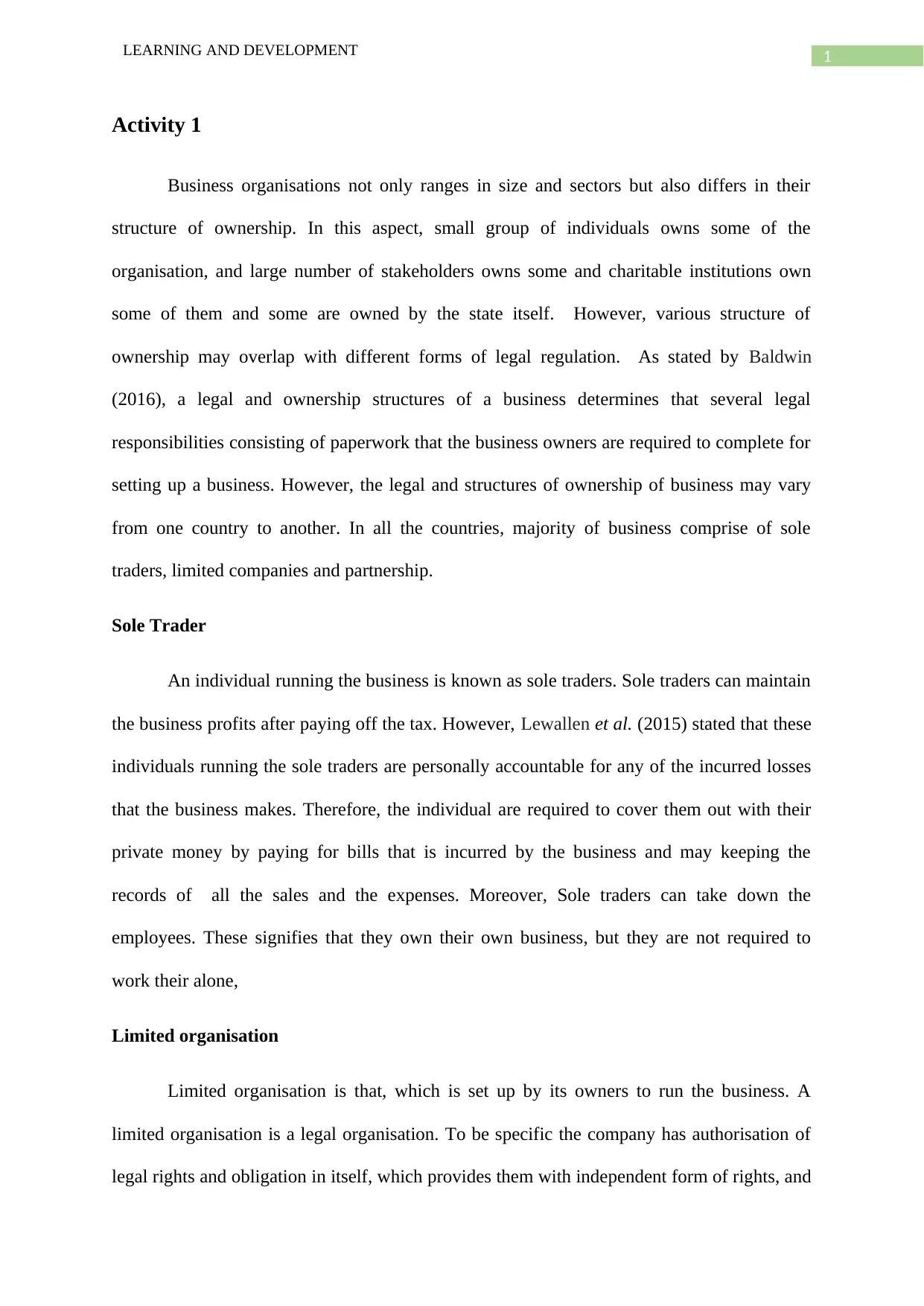
1LEARNING AND DEVELOPMENT
Activity 1
Business organisations not only ranges in size and sectors but also differs in their
structure of ownership. In this aspect, small group of individuals owns some of the
organisation, and large number of stakeholders owns some and charitable institutions own
some of them and some are owned by the state itself. However, various structure of
ownership may overlap with different forms of legal regulation. As stated by Baldwin
(2016), a legal and ownership structures of a business determines that several legal
responsibilities consisting of paperwork that the business owners are required to complete for
setting up a business. However, the legal and structures of ownership of business may vary
from one country to another. In all the countries, majority of business comprise of sole
traders, limited companies and partnership.
Sole Trader
An individual running the business is known as sole traders. Sole traders can maintain
the business profits after paying off the tax. However, Lewallen et al. (2015) stated that these
individuals running the sole traders are personally accountable for any of the incurred losses
that the business makes. Therefore, the individual are required to cover them out with their
private money by paying for bills that is incurred by the business and may keeping the
records of all the sales and the expenses. Moreover, Sole traders can take down the
employees. These signifies that they own their own business, but they are not required to
work their alone,
Limited organisation
Limited organisation is that, which is set up by its owners to run the business. A
limited organisation is a legal organisation. To be specific the company has authorisation of
legal rights and obligation in itself, which provides them with independent form of rights, and
Activity 1
Business organisations not only ranges in size and sectors but also differs in their
structure of ownership. In this aspect, small group of individuals owns some of the
organisation, and large number of stakeholders owns some and charitable institutions own
some of them and some are owned by the state itself. However, various structure of
ownership may overlap with different forms of legal regulation. As stated by Baldwin
(2016), a legal and ownership structures of a business determines that several legal
responsibilities consisting of paperwork that the business owners are required to complete for
setting up a business. However, the legal and structures of ownership of business may vary
from one country to another. In all the countries, majority of business comprise of sole
traders, limited companies and partnership.
Sole Trader
An individual running the business is known as sole traders. Sole traders can maintain
the business profits after paying off the tax. However, Lewallen et al. (2015) stated that these
individuals running the sole traders are personally accountable for any of the incurred losses
that the business makes. Therefore, the individual are required to cover them out with their
private money by paying for bills that is incurred by the business and may keeping the
records of all the sales and the expenses. Moreover, Sole traders can take down the
employees. These signifies that they own their own business, but they are not required to
work their alone,
Limited organisation
Limited organisation is that, which is set up by its owners to run the business. A
limited organisation is a legal organisation. To be specific the company has authorisation of
legal rights and obligation in itself, which provides them with independent form of rights, and
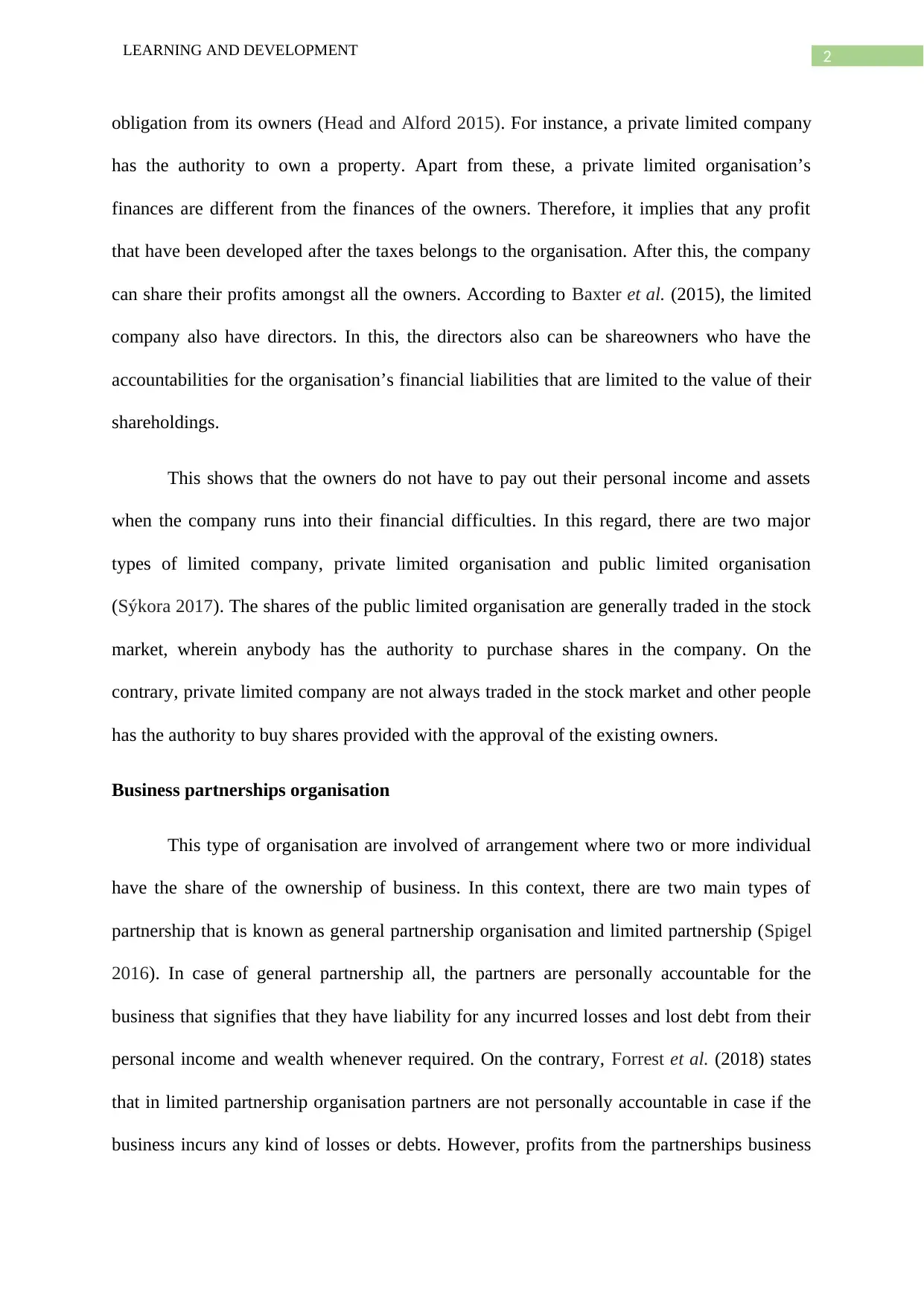
2LEARNING AND DEVELOPMENT
obligation from its owners (Head and Alford 2015). For instance, a private limited company
has the authority to own a property. Apart from these, a private limited organisation’s
finances are different from the finances of the owners. Therefore, it implies that any profit
that have been developed after the taxes belongs to the organisation. After this, the company
can share their profits amongst all the owners. According to Baxter et al. (2015), the limited
company also have directors. In this, the directors also can be shareowners who have the
accountabilities for the organisation’s financial liabilities that are limited to the value of their
shareholdings.
This shows that the owners do not have to pay out their personal income and assets
when the company runs into their financial difficulties. In this regard, there are two major
types of limited company, private limited organisation and public limited organisation
(Sýkora 2017). The shares of the public limited organisation are generally traded in the stock
market, wherein anybody has the authority to purchase shares in the company. On the
contrary, private limited company are not always traded in the stock market and other people
has the authority to buy shares provided with the approval of the existing owners.
Business partnerships organisation
This type of organisation are involved of arrangement where two or more individual
have the share of the ownership of business. In this context, there are two main types of
partnership that is known as general partnership organisation and limited partnership (Spigel
2016). In case of general partnership all, the partners are personally accountable for the
business that signifies that they have liability for any incurred losses and lost debt from their
personal income and wealth whenever required. On the contrary, Forrest et al. (2018) states
that in limited partnership organisation partners are not personally accountable in case if the
business incurs any kind of losses or debts. However, profits from the partnerships business
obligation from its owners (Head and Alford 2015). For instance, a private limited company
has the authority to own a property. Apart from these, a private limited organisation’s
finances are different from the finances of the owners. Therefore, it implies that any profit
that have been developed after the taxes belongs to the organisation. After this, the company
can share their profits amongst all the owners. According to Baxter et al. (2015), the limited
company also have directors. In this, the directors also can be shareowners who have the
accountabilities for the organisation’s financial liabilities that are limited to the value of their
shareholdings.
This shows that the owners do not have to pay out their personal income and assets
when the company runs into their financial difficulties. In this regard, there are two major
types of limited company, private limited organisation and public limited organisation
(Sýkora 2017). The shares of the public limited organisation are generally traded in the stock
market, wherein anybody has the authority to purchase shares in the company. On the
contrary, private limited company are not always traded in the stock market and other people
has the authority to buy shares provided with the approval of the existing owners.
Business partnerships organisation
This type of organisation are involved of arrangement where two or more individual
have the share of the ownership of business. In this context, there are two main types of
partnership that is known as general partnership organisation and limited partnership (Spigel
2016). In case of general partnership all, the partners are personally accountable for the
business that signifies that they have liability for any incurred losses and lost debt from their
personal income and wealth whenever required. On the contrary, Forrest et al. (2018) states
that in limited partnership organisation partners are not personally accountable in case if the
business incurs any kind of losses or debts. However, profits from the partnerships business
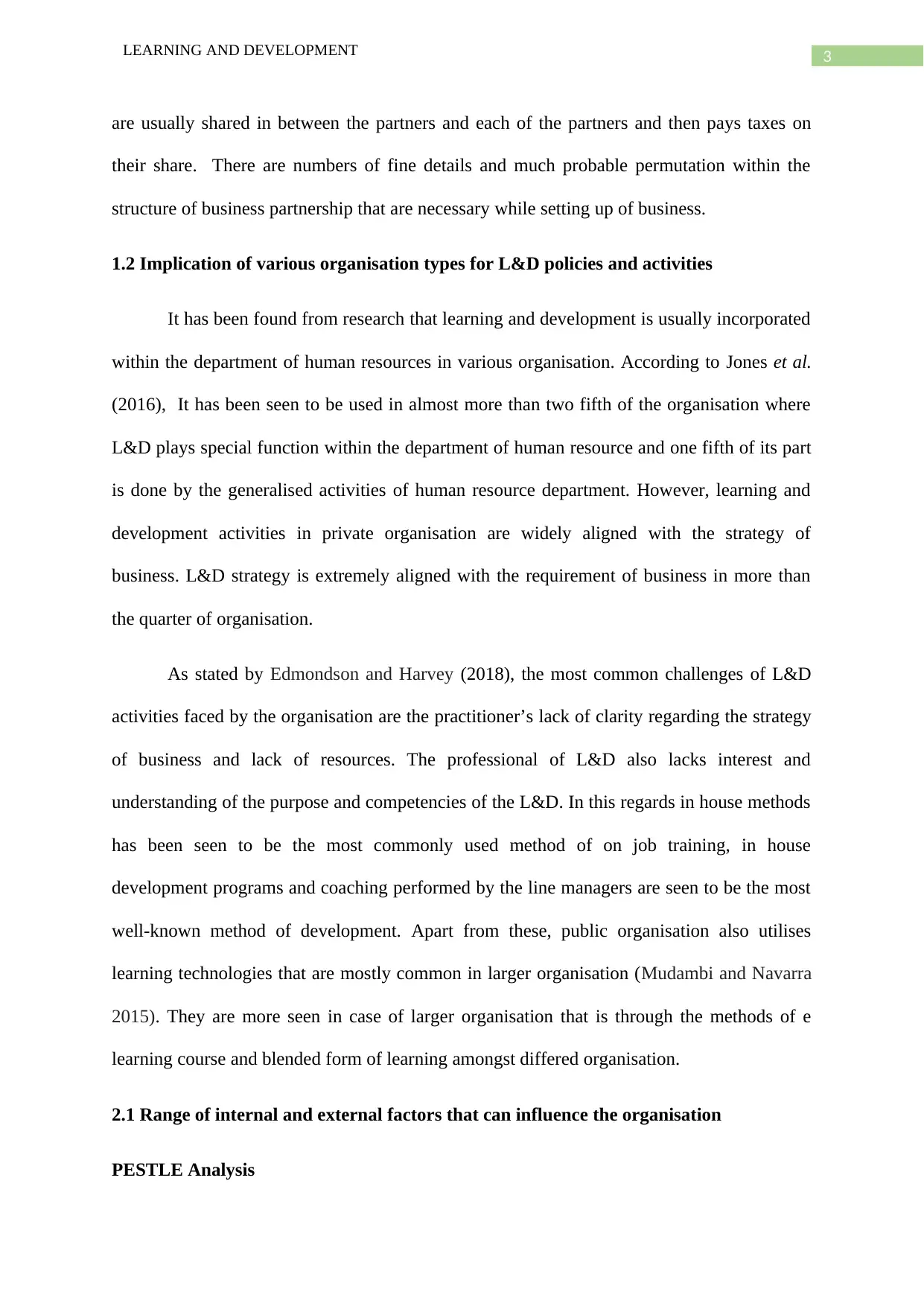
3LEARNING AND DEVELOPMENT
are usually shared in between the partners and each of the partners and then pays taxes on
their share. There are numbers of fine details and much probable permutation within the
structure of business partnership that are necessary while setting up of business.
1.2 Implication of various organisation types for L&D policies and activities
It has been found from research that learning and development is usually incorporated
within the department of human resources in various organisation. According to Jones et al.
(2016), It has been seen to be used in almost more than two fifth of the organisation where
L&D plays special function within the department of human resource and one fifth of its part
is done by the generalised activities of human resource department. However, learning and
development activities in private organisation are widely aligned with the strategy of
business. L&D strategy is extremely aligned with the requirement of business in more than
the quarter of organisation.
As stated by Edmondson and Harvey (2018), the most common challenges of L&D
activities faced by the organisation are the practitioner’s lack of clarity regarding the strategy
of business and lack of resources. The professional of L&D also lacks interest and
understanding of the purpose and competencies of the L&D. In this regards in house methods
has been seen to be the most commonly used method of on job training, in house
development programs and coaching performed by the line managers are seen to be the most
well-known method of development. Apart from these, public organisation also utilises
learning technologies that are mostly common in larger organisation (Mudambi and Navarra
2015). They are more seen in case of larger organisation that is through the methods of e
learning course and blended form of learning amongst differed organisation.
2.1 Range of internal and external factors that can influence the organisation
PESTLE Analysis
are usually shared in between the partners and each of the partners and then pays taxes on
their share. There are numbers of fine details and much probable permutation within the
structure of business partnership that are necessary while setting up of business.
1.2 Implication of various organisation types for L&D policies and activities
It has been found from research that learning and development is usually incorporated
within the department of human resources in various organisation. According to Jones et al.
(2016), It has been seen to be used in almost more than two fifth of the organisation where
L&D plays special function within the department of human resource and one fifth of its part
is done by the generalised activities of human resource department. However, learning and
development activities in private organisation are widely aligned with the strategy of
business. L&D strategy is extremely aligned with the requirement of business in more than
the quarter of organisation.
As stated by Edmondson and Harvey (2018), the most common challenges of L&D
activities faced by the organisation are the practitioner’s lack of clarity regarding the strategy
of business and lack of resources. The professional of L&D also lacks interest and
understanding of the purpose and competencies of the L&D. In this regards in house methods
has been seen to be the most commonly used method of on job training, in house
development programs and coaching performed by the line managers are seen to be the most
well-known method of development. Apart from these, public organisation also utilises
learning technologies that are mostly common in larger organisation (Mudambi and Navarra
2015). They are more seen in case of larger organisation that is through the methods of e
learning course and blended form of learning amongst differed organisation.
2.1 Range of internal and external factors that can influence the organisation
PESTLE Analysis
Secure Best Marks with AI Grader
Need help grading? Try our AI Grader for instant feedback on your assignments.
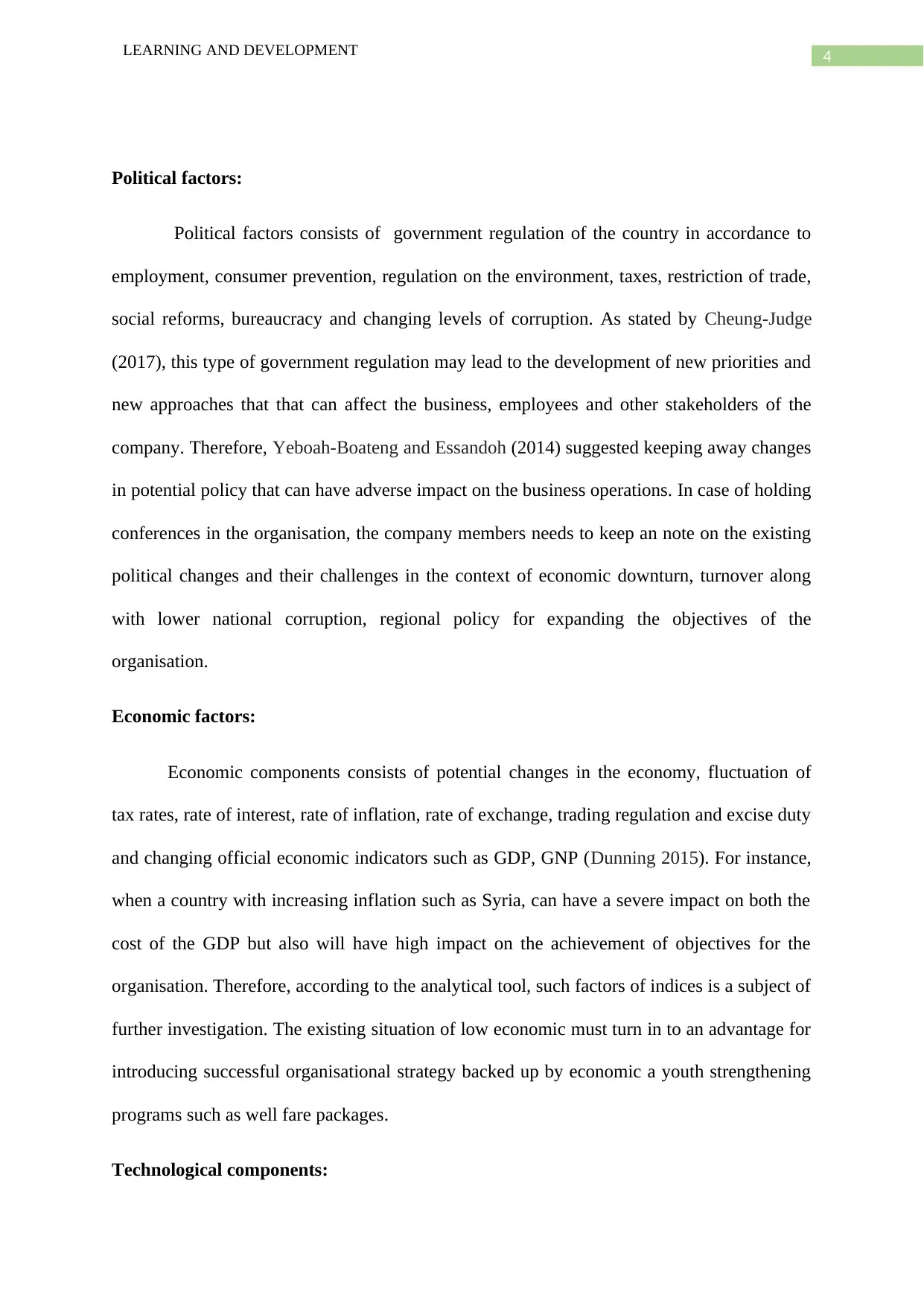
4LEARNING AND DEVELOPMENT
Political factors:
Political factors consists of government regulation of the country in accordance to
employment, consumer prevention, regulation on the environment, taxes, restriction of trade,
social reforms, bureaucracy and changing levels of corruption. As stated by Cheung-Judge
(2017), this type of government regulation may lead to the development of new priorities and
new approaches that that can affect the business, employees and other stakeholders of the
company. Therefore, Yeboah-Boateng and Essandoh (2014) suggested keeping away changes
in potential policy that can have adverse impact on the business operations. In case of holding
conferences in the organisation, the company members needs to keep an note on the existing
political changes and their challenges in the context of economic downturn, turnover along
with lower national corruption, regional policy for expanding the objectives of the
organisation.
Economic factors:
Economic components consists of potential changes in the economy, fluctuation of
tax rates, rate of interest, rate of inflation, rate of exchange, trading regulation and excise duty
and changing official economic indicators such as GDP, GNP (Dunning 2015). For instance,
when a country with increasing inflation such as Syria, can have a severe impact on both the
cost of the GDP but also will have high impact on the achievement of objectives for the
organisation. Therefore, according to the analytical tool, such factors of indices is a subject of
further investigation. The existing situation of low economic must turn in to an advantage for
introducing successful organisational strategy backed up by economic a youth strengthening
programs such as well fare packages.
Technological components:
Political factors:
Political factors consists of government regulation of the country in accordance to
employment, consumer prevention, regulation on the environment, taxes, restriction of trade,
social reforms, bureaucracy and changing levels of corruption. As stated by Cheung-Judge
(2017), this type of government regulation may lead to the development of new priorities and
new approaches that that can affect the business, employees and other stakeholders of the
company. Therefore, Yeboah-Boateng and Essandoh (2014) suggested keeping away changes
in potential policy that can have adverse impact on the business operations. In case of holding
conferences in the organisation, the company members needs to keep an note on the existing
political changes and their challenges in the context of economic downturn, turnover along
with lower national corruption, regional policy for expanding the objectives of the
organisation.
Economic factors:
Economic components consists of potential changes in the economy, fluctuation of
tax rates, rate of interest, rate of inflation, rate of exchange, trading regulation and excise duty
and changing official economic indicators such as GDP, GNP (Dunning 2015). For instance,
when a country with increasing inflation such as Syria, can have a severe impact on both the
cost of the GDP but also will have high impact on the achievement of objectives for the
organisation. Therefore, according to the analytical tool, such factors of indices is a subject of
further investigation. The existing situation of low economic must turn in to an advantage for
introducing successful organisational strategy backed up by economic a youth strengthening
programs such as well fare packages.
Technological components:
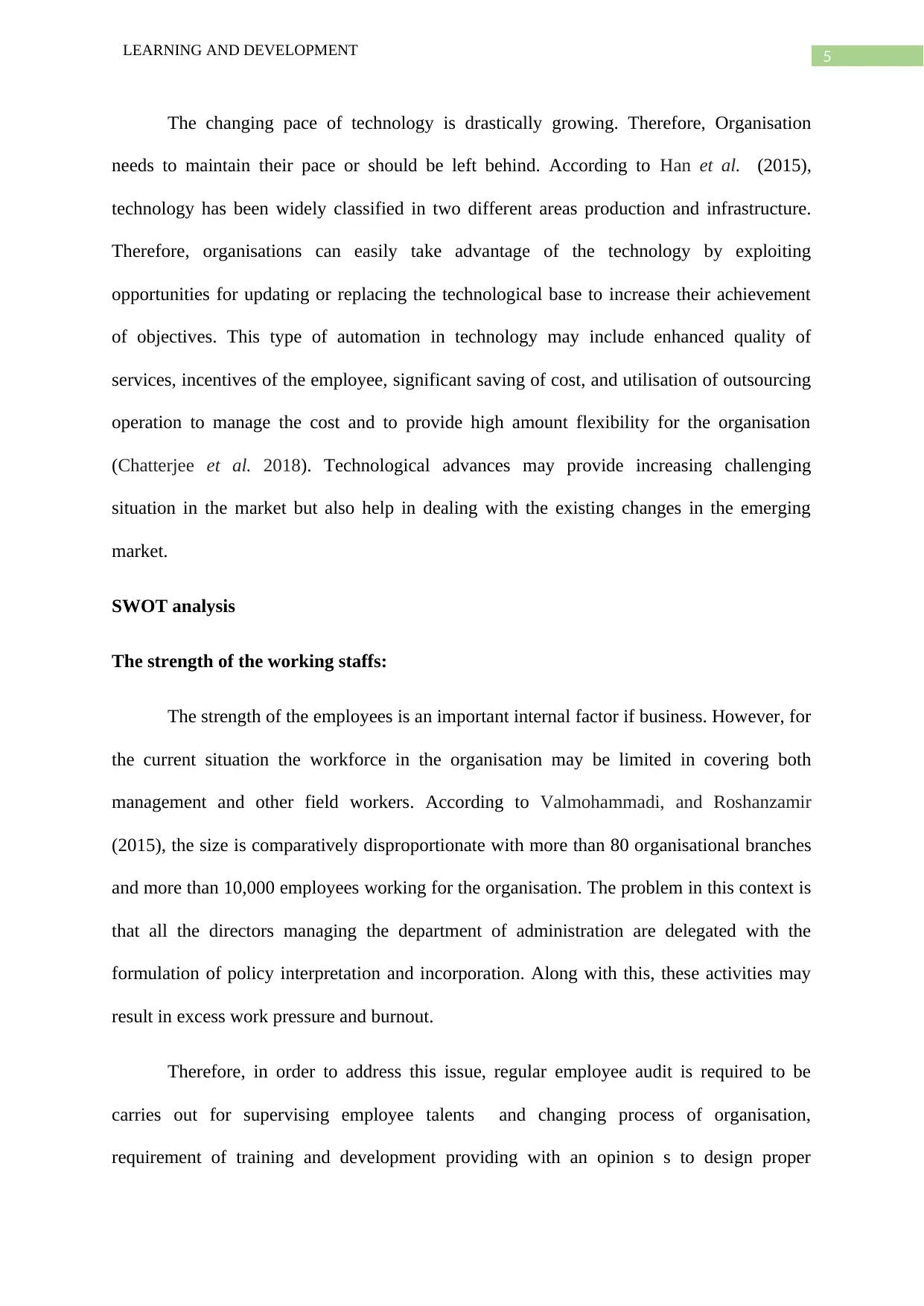
5LEARNING AND DEVELOPMENT
The changing pace of technology is drastically growing. Therefore, Organisation
needs to maintain their pace or should be left behind. According to Han et al. (2015),
technology has been widely classified in two different areas production and infrastructure.
Therefore, organisations can easily take advantage of the technology by exploiting
opportunities for updating or replacing the technological base to increase their achievement
of objectives. This type of automation in technology may include enhanced quality of
services, incentives of the employee, significant saving of cost, and utilisation of outsourcing
operation to manage the cost and to provide high amount flexibility for the organisation
(Chatterjee et al. 2018). Technological advances may provide increasing challenging
situation in the market but also help in dealing with the existing changes in the emerging
market.
SWOT analysis
The strength of the working staffs:
The strength of the employees is an important internal factor if business. However, for
the current situation the workforce in the organisation may be limited in covering both
management and other field workers. According to Valmohammadi, and Roshanzamir
(2015), the size is comparatively disproportionate with more than 80 organisational branches
and more than 10,000 employees working for the organisation. The problem in this context is
that all the directors managing the department of administration are delegated with the
formulation of policy interpretation and incorporation. Along with this, these activities may
result in excess work pressure and burnout.
Therefore, in order to address this issue, regular employee audit is required to be
carries out for supervising employee talents and changing process of organisation,
requirement of training and development providing with an opinion s to design proper
The changing pace of technology is drastically growing. Therefore, Organisation
needs to maintain their pace or should be left behind. According to Han et al. (2015),
technology has been widely classified in two different areas production and infrastructure.
Therefore, organisations can easily take advantage of the technology by exploiting
opportunities for updating or replacing the technological base to increase their achievement
of objectives. This type of automation in technology may include enhanced quality of
services, incentives of the employee, significant saving of cost, and utilisation of outsourcing
operation to manage the cost and to provide high amount flexibility for the organisation
(Chatterjee et al. 2018). Technological advances may provide increasing challenging
situation in the market but also help in dealing with the existing changes in the emerging
market.
SWOT analysis
The strength of the working staffs:
The strength of the employees is an important internal factor if business. However, for
the current situation the workforce in the organisation may be limited in covering both
management and other field workers. According to Valmohammadi, and Roshanzamir
(2015), the size is comparatively disproportionate with more than 80 organisational branches
and more than 10,000 employees working for the organisation. The problem in this context is
that all the directors managing the department of administration are delegated with the
formulation of policy interpretation and incorporation. Along with this, these activities may
result in excess work pressure and burnout.
Therefore, in order to address this issue, regular employee audit is required to be
carries out for supervising employee talents and changing process of organisation,
requirement of training and development providing with an opinion s to design proper
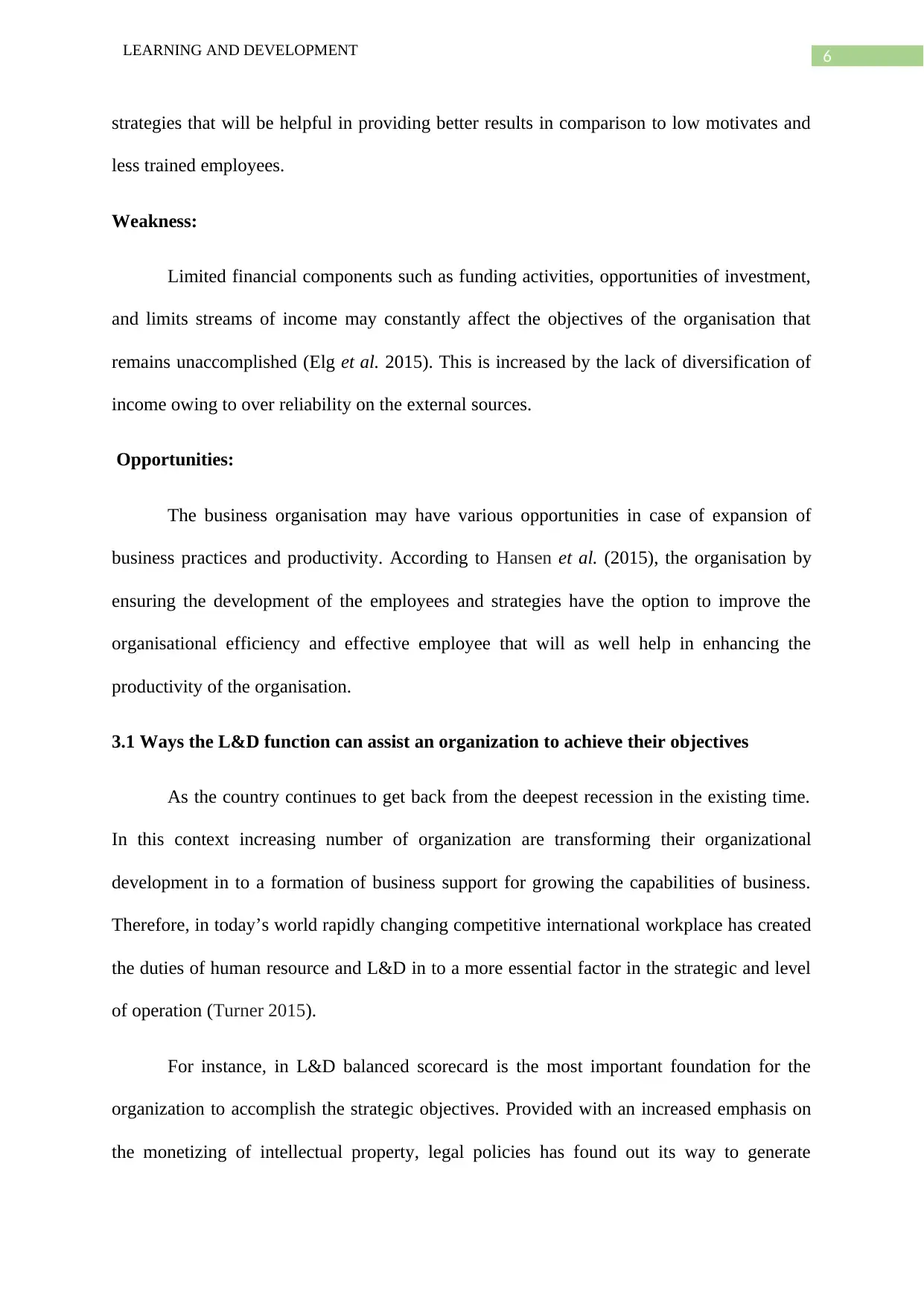
6LEARNING AND DEVELOPMENT
strategies that will be helpful in providing better results in comparison to low motivates and
less trained employees.
Weakness:
Limited financial components such as funding activities, opportunities of investment,
and limits streams of income may constantly affect the objectives of the organisation that
remains unaccomplished (Elg et al. 2015). This is increased by the lack of diversification of
income owing to over reliability on the external sources.
Opportunities:
The business organisation may have various opportunities in case of expansion of
business practices and productivity. According to Hansen et al. (2015), the organisation by
ensuring the development of the employees and strategies have the option to improve the
organisational efficiency and effective employee that will as well help in enhancing the
productivity of the organisation.
3.1 Ways the L&D function can assist an organization to achieve their objectives
As the country continues to get back from the deepest recession in the existing time.
In this context increasing number of organization are transforming their organizational
development in to a formation of business support for growing the capabilities of business.
Therefore, in today’s world rapidly changing competitive international workplace has created
the duties of human resource and L&D in to a more essential factor in the strategic and level
of operation (Turner 2015).
For instance, in L&D balanced scorecard is the most important foundation for the
organization to accomplish the strategic objectives. Provided with an increased emphasis on
the monetizing of intellectual property, legal policies has found out its way to generate
strategies that will be helpful in providing better results in comparison to low motivates and
less trained employees.
Weakness:
Limited financial components such as funding activities, opportunities of investment,
and limits streams of income may constantly affect the objectives of the organisation that
remains unaccomplished (Elg et al. 2015). This is increased by the lack of diversification of
income owing to over reliability on the external sources.
Opportunities:
The business organisation may have various opportunities in case of expansion of
business practices and productivity. According to Hansen et al. (2015), the organisation by
ensuring the development of the employees and strategies have the option to improve the
organisational efficiency and effective employee that will as well help in enhancing the
productivity of the organisation.
3.1 Ways the L&D function can assist an organization to achieve their objectives
As the country continues to get back from the deepest recession in the existing time.
In this context increasing number of organization are transforming their organizational
development in to a formation of business support for growing the capabilities of business.
Therefore, in today’s world rapidly changing competitive international workplace has created
the duties of human resource and L&D in to a more essential factor in the strategic and level
of operation (Turner 2015).
For instance, in L&D balanced scorecard is the most important foundation for the
organization to accomplish the strategic objectives. Provided with an increased emphasis on
the monetizing of intellectual property, legal policies has found out its way to generate
Paraphrase This Document
Need a fresh take? Get an instant paraphrase of this document with our AI Paraphraser
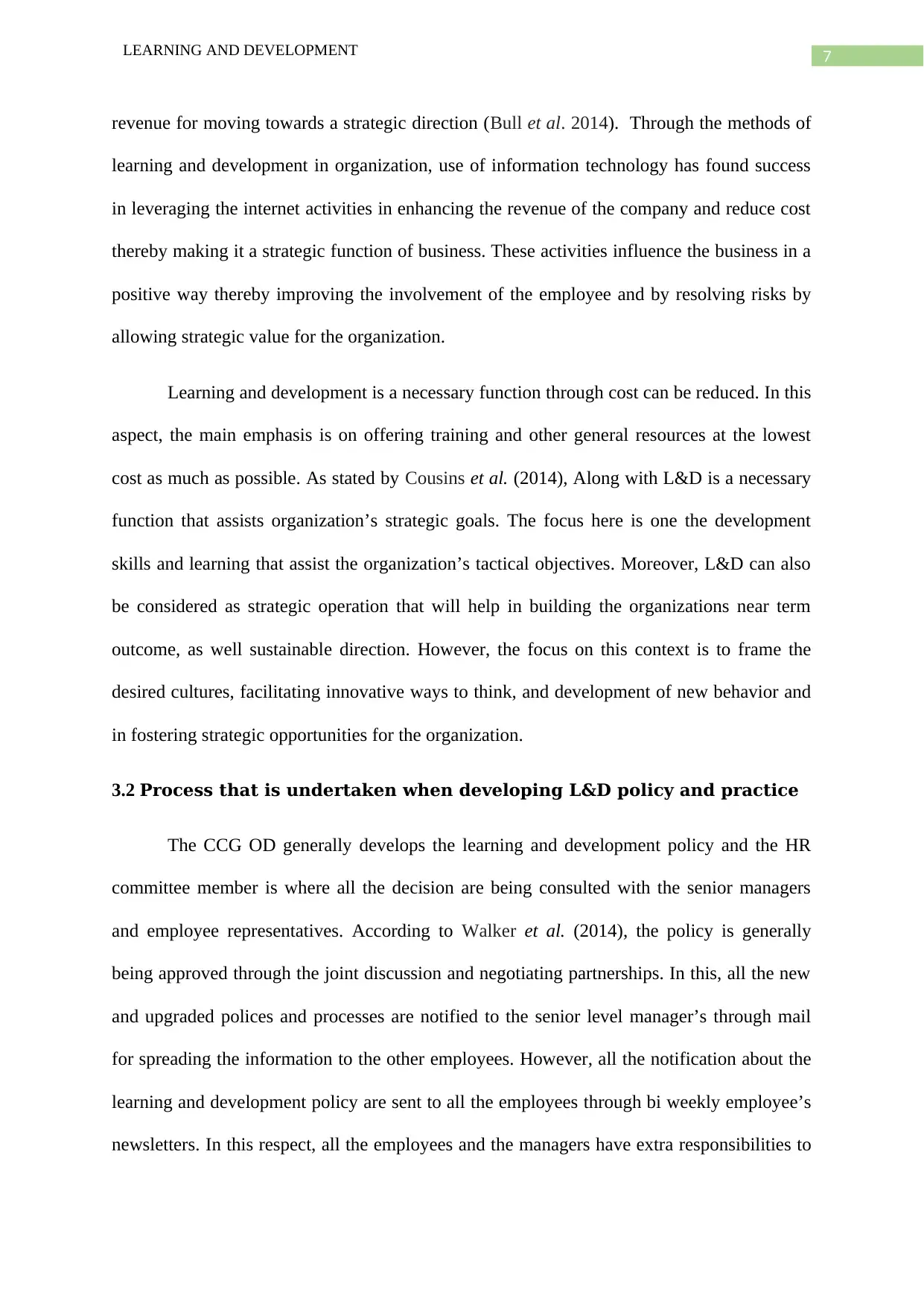
7LEARNING AND DEVELOPMENT
revenue for moving towards a strategic direction (Bull et al. 2014). Through the methods of
learning and development in organization, use of information technology has found success
in leveraging the internet activities in enhancing the revenue of the company and reduce cost
thereby making it a strategic function of business. These activities influence the business in a
positive way thereby improving the involvement of the employee and by resolving risks by
allowing strategic value for the organization.
Learning and development is a necessary function through cost can be reduced. In this
aspect, the main emphasis is on offering training and other general resources at the lowest
cost as much as possible. As stated by Cousins et al. (2014), Along with L&D is a necessary
function that assists organization’s strategic goals. The focus here is one the development
skills and learning that assist the organization’s tactical objectives. Moreover, L&D can also
be considered as strategic operation that will help in building the organizations near term
outcome, as well sustainable direction. However, the focus on this context is to frame the
desired cultures, facilitating innovative ways to think, and development of new behavior and
in fostering strategic opportunities for the organization.
3.2 Process that is undertaken when developing L&D policy and practice
The CCG OD generally develops the learning and development policy and the HR
committee member is where all the decision are being consulted with the senior managers
and employee representatives. According to Walker et al. (2014), the policy is generally
being approved through the joint discussion and negotiating partnerships. In this, all the new
and upgraded polices and processes are notified to the senior level manager’s through mail
for spreading the information to the other employees. However, all the notification about the
learning and development policy are sent to all the employees through bi weekly employee’s
newsletters. In this respect, all the employees and the managers have extra responsibilities to
revenue for moving towards a strategic direction (Bull et al. 2014). Through the methods of
learning and development in organization, use of information technology has found success
in leveraging the internet activities in enhancing the revenue of the company and reduce cost
thereby making it a strategic function of business. These activities influence the business in a
positive way thereby improving the involvement of the employee and by resolving risks by
allowing strategic value for the organization.
Learning and development is a necessary function through cost can be reduced. In this
aspect, the main emphasis is on offering training and other general resources at the lowest
cost as much as possible. As stated by Cousins et al. (2014), Along with L&D is a necessary
function that assists organization’s strategic goals. The focus here is one the development
skills and learning that assist the organization’s tactical objectives. Moreover, L&D can also
be considered as strategic operation that will help in building the organizations near term
outcome, as well sustainable direction. However, the focus on this context is to frame the
desired cultures, facilitating innovative ways to think, and development of new behavior and
in fostering strategic opportunities for the organization.
3.2 Process that is undertaken when developing L&D policy and practice
The CCG OD generally develops the learning and development policy and the HR
committee member is where all the decision are being consulted with the senior managers
and employee representatives. According to Walker et al. (2014), the policy is generally
being approved through the joint discussion and negotiating partnerships. In this, all the new
and upgraded polices and processes are notified to the senior level manager’s through mail
for spreading the information to the other employees. However, all the notification about the
learning and development policy are sent to all the employees through bi weekly employee’s
newsletters. In this respect, all the employees and the managers have extra responsibilities to
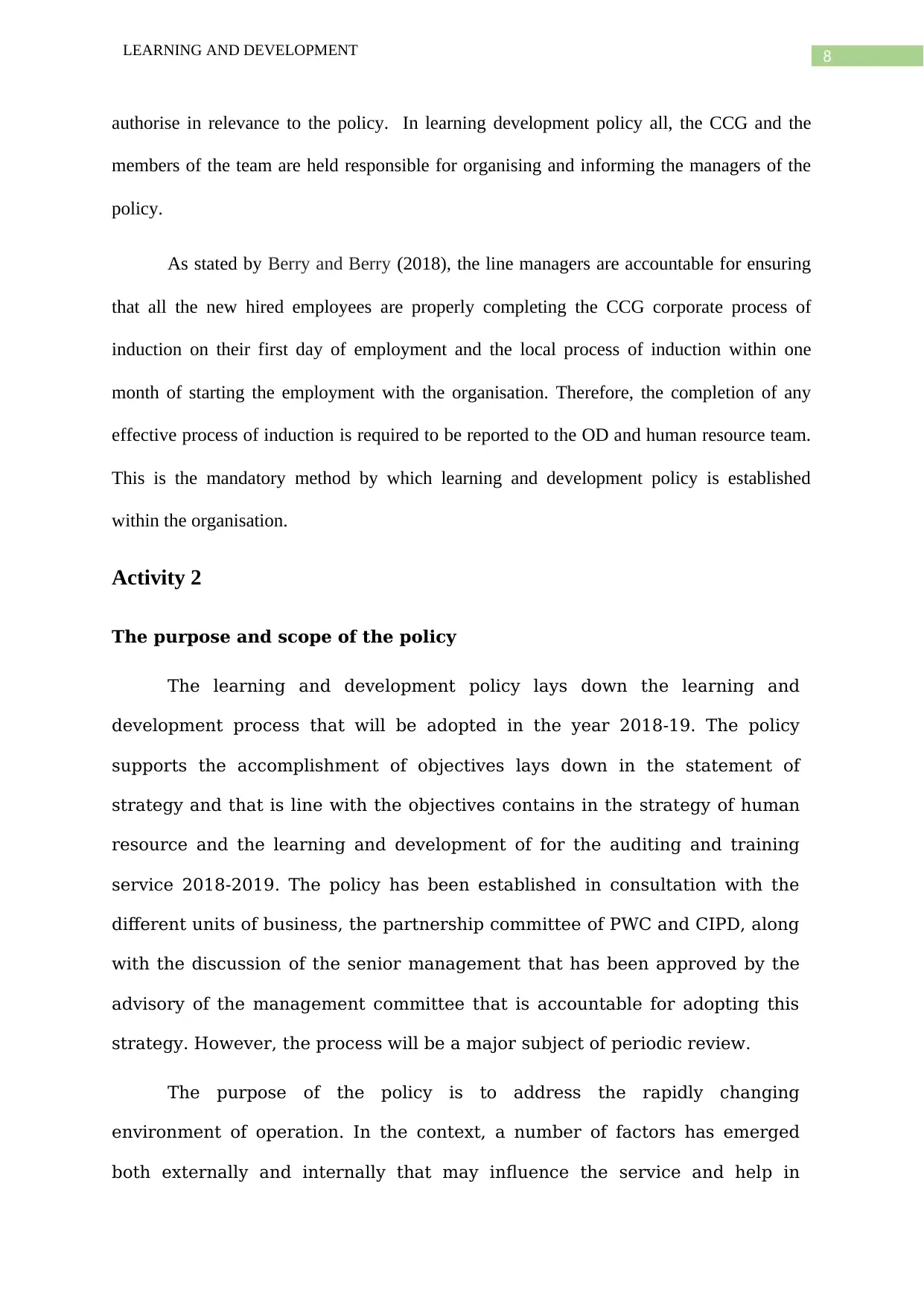
8LEARNING AND DEVELOPMENT
authorise in relevance to the policy. In learning development policy all, the CCG and the
members of the team are held responsible for organising and informing the managers of the
policy.
As stated by Berry and Berry (2018), the line managers are accountable for ensuring
that all the new hired employees are properly completing the CCG corporate process of
induction on their first day of employment and the local process of induction within one
month of starting the employment with the organisation. Therefore, the completion of any
effective process of induction is required to be reported to the OD and human resource team.
This is the mandatory method by which learning and development policy is established
within the organisation.
Activity 2
The purpose and scope of the policy
The learning and development policy lays down the learning and
development process that will be adopted in the year 2018-19. The policy
supports the accomplishment of objectives lays down in the statement of
strategy and that is line with the objectives contains in the strategy of human
resource and the learning and development of for the auditing and training
service 2018-2019. The policy has been established in consultation with the
different units of business, the partnership committee of PWC and CIPD, along
with the discussion of the senior management that has been approved by the
advisory of the management committee that is accountable for adopting this
strategy. However, the process will be a major subject of periodic review.
The purpose of the policy is to address the rapidly changing
environment of operation. In the context, a number of factors has emerged
both externally and internally that may influence the service and help in
authorise in relevance to the policy. In learning development policy all, the CCG and the
members of the team are held responsible for organising and informing the managers of the
policy.
As stated by Berry and Berry (2018), the line managers are accountable for ensuring
that all the new hired employees are properly completing the CCG corporate process of
induction on their first day of employment and the local process of induction within one
month of starting the employment with the organisation. Therefore, the completion of any
effective process of induction is required to be reported to the OD and human resource team.
This is the mandatory method by which learning and development policy is established
within the organisation.
Activity 2
The purpose and scope of the policy
The learning and development policy lays down the learning and
development process that will be adopted in the year 2018-19. The policy
supports the accomplishment of objectives lays down in the statement of
strategy and that is line with the objectives contains in the strategy of human
resource and the learning and development of for the auditing and training
service 2018-2019. The policy has been established in consultation with the
different units of business, the partnership committee of PWC and CIPD, along
with the discussion of the senior management that has been approved by the
advisory of the management committee that is accountable for adopting this
strategy. However, the process will be a major subject of periodic review.
The purpose of the policy is to address the rapidly changing
environment of operation. In the context, a number of factors has emerged
both externally and internally that may influence the service and help in
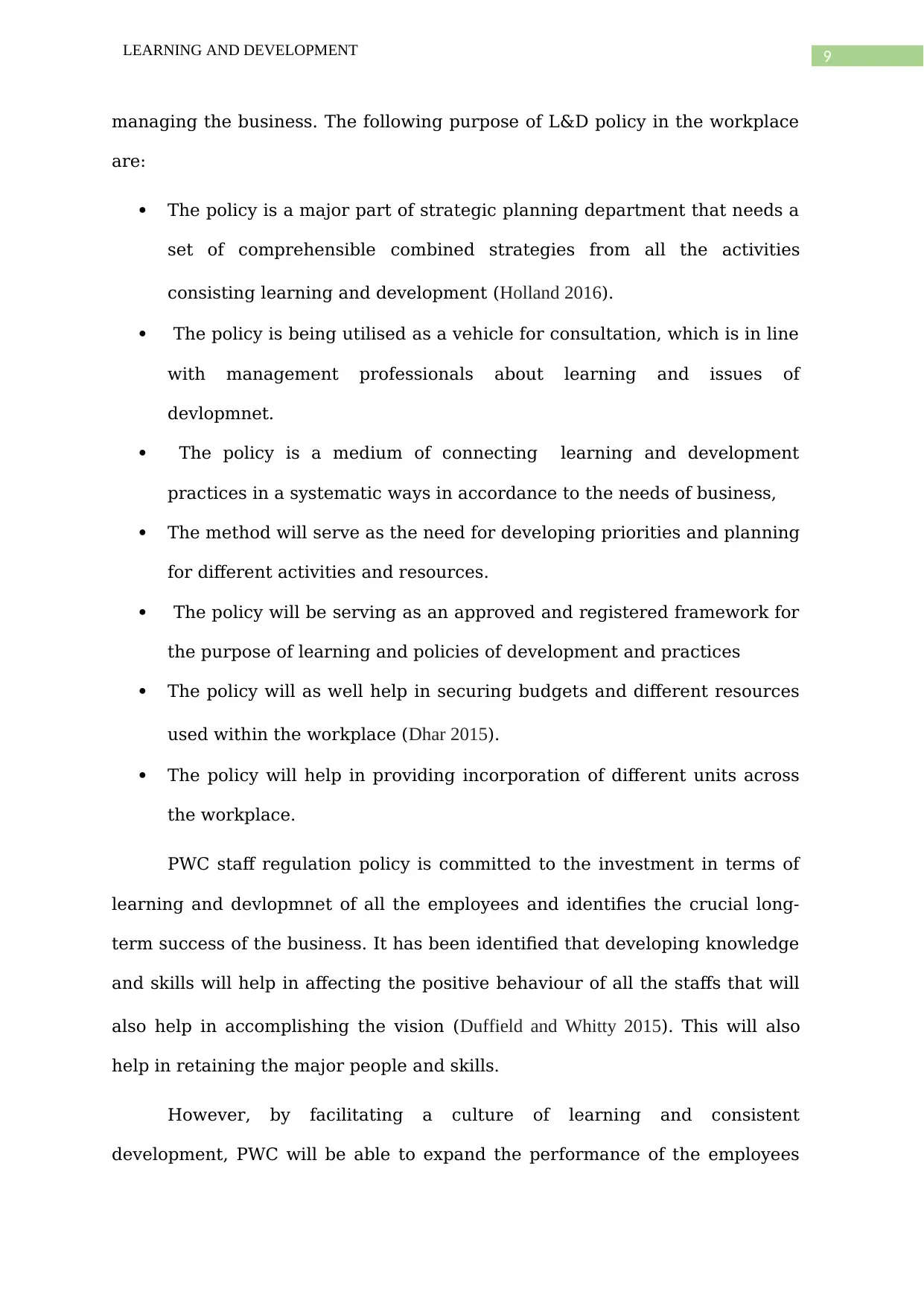
9LEARNING AND DEVELOPMENT
managing the business. The following purpose of L&D policy in the workplace
are:
The policy is a major part of strategic planning department that needs a
set of comprehensible combined strategies from all the activities
consisting learning and development (Holland 2016).
The policy is being utilised as a vehicle for consultation, which is in line
with management professionals about learning and issues of
devlopmnet.
The policy is a medium of connecting learning and development
practices in a systematic ways in accordance to the needs of business,
The method will serve as the need for developing priorities and planning
for different activities and resources.
The policy will be serving as an approved and registered framework for
the purpose of learning and policies of development and practices
The policy will as well help in securing budgets and different resources
used within the workplace (Dhar 2015).
The policy will help in providing incorporation of different units across
the workplace.
PWC staff regulation policy is committed to the investment in terms of
learning and devlopmnet of all the employees and identifies the crucial long-
term success of the business. It has been identified that developing knowledge
and skills will help in affecting the positive behaviour of all the staffs that will
also help in accomplishing the vision (Duffield and Whitty 2015). This will also
help in retaining the major people and skills.
However, by facilitating a culture of learning and consistent
development, PWC will be able to expand the performance of the employees
managing the business. The following purpose of L&D policy in the workplace
are:
The policy is a major part of strategic planning department that needs a
set of comprehensible combined strategies from all the activities
consisting learning and development (Holland 2016).
The policy is being utilised as a vehicle for consultation, which is in line
with management professionals about learning and issues of
devlopmnet.
The policy is a medium of connecting learning and development
practices in a systematic ways in accordance to the needs of business,
The method will serve as the need for developing priorities and planning
for different activities and resources.
The policy will be serving as an approved and registered framework for
the purpose of learning and policies of development and practices
The policy will as well help in securing budgets and different resources
used within the workplace (Dhar 2015).
The policy will help in providing incorporation of different units across
the workplace.
PWC staff regulation policy is committed to the investment in terms of
learning and devlopmnet of all the employees and identifies the crucial long-
term success of the business. It has been identified that developing knowledge
and skills will help in affecting the positive behaviour of all the staffs that will
also help in accomplishing the vision (Duffield and Whitty 2015). This will also
help in retaining the major people and skills.
However, by facilitating a culture of learning and consistent
development, PWC will be able to expand the performance of the employees
Secure Best Marks with AI Grader
Need help grading? Try our AI Grader for instant feedback on your assignments.
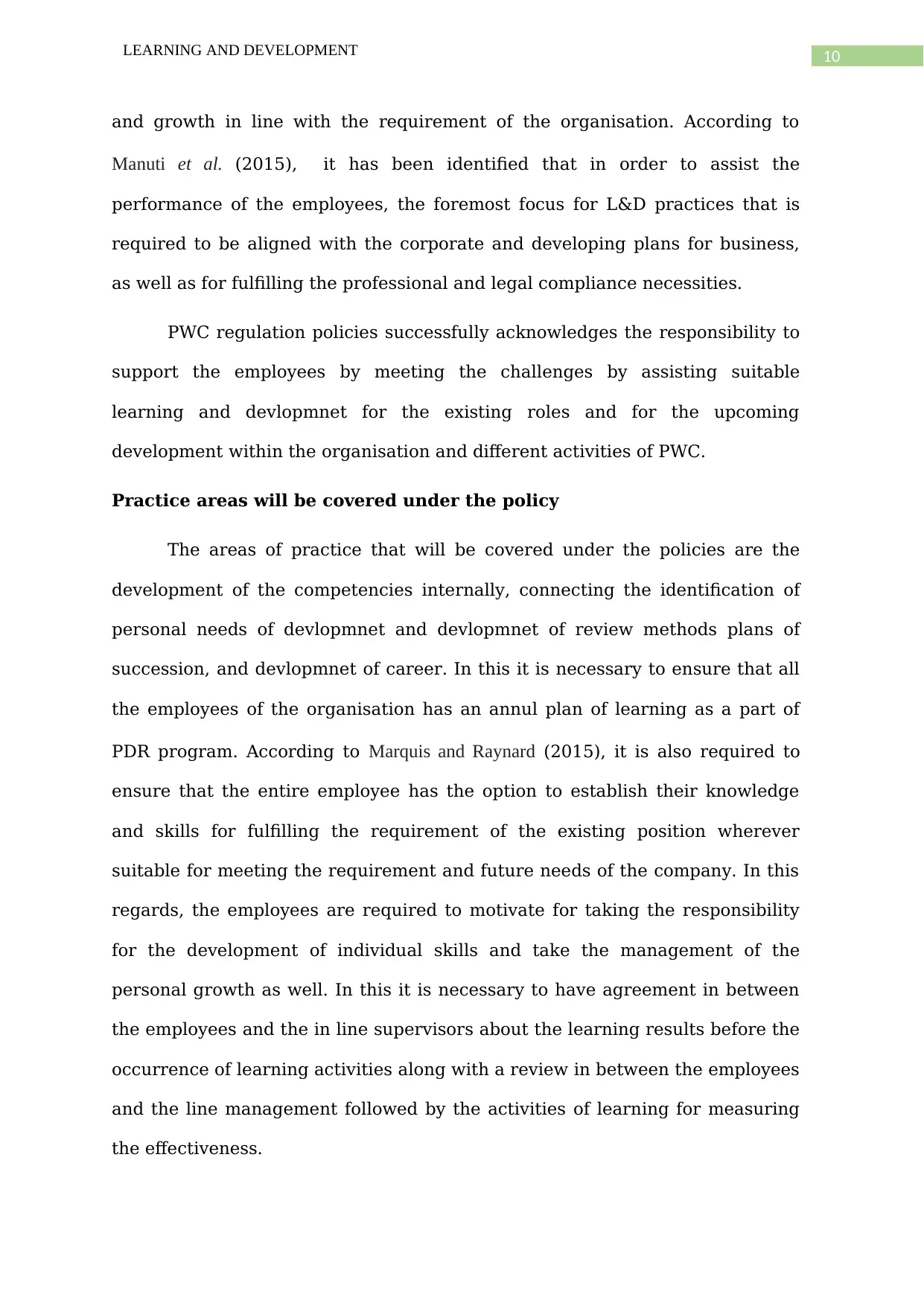
10LEARNING AND DEVELOPMENT
and growth in line with the requirement of the organisation. According to
Manuti et al. (2015), it has been identified that in order to assist the
performance of the employees, the foremost focus for L&D practices that is
required to be aligned with the corporate and developing plans for business,
as well as for fulfilling the professional and legal compliance necessities.
PWC regulation policies successfully acknowledges the responsibility to
support the employees by meeting the challenges by assisting suitable
learning and devlopmnet for the existing roles and for the upcoming
development within the organisation and different activities of PWC.
Practice areas will be covered under the policy
The areas of practice that will be covered under the policies are the
development of the competencies internally, connecting the identification of
personal needs of devlopmnet and devlopmnet of review methods plans of
succession, and devlopmnet of career. In this it is necessary to ensure that all
the employees of the organisation has an annul plan of learning as a part of
PDR program. According to Marquis and Raynard (2015), it is also required to
ensure that the entire employee has the option to establish their knowledge
and skills for fulfilling the requirement of the existing position wherever
suitable for meeting the requirement and future needs of the company. In this
regards, the employees are required to motivate for taking the responsibility
for the development of individual skills and take the management of the
personal growth as well. In this it is necessary to have agreement in between
the employees and the in line supervisors about the learning results before the
occurrence of learning activities along with a review in between the employees
and the line management followed by the activities of learning for measuring
the effectiveness.
and growth in line with the requirement of the organisation. According to
Manuti et al. (2015), it has been identified that in order to assist the
performance of the employees, the foremost focus for L&D practices that is
required to be aligned with the corporate and developing plans for business,
as well as for fulfilling the professional and legal compliance necessities.
PWC regulation policies successfully acknowledges the responsibility to
support the employees by meeting the challenges by assisting suitable
learning and devlopmnet for the existing roles and for the upcoming
development within the organisation and different activities of PWC.
Practice areas will be covered under the policy
The areas of practice that will be covered under the policies are the
development of the competencies internally, connecting the identification of
personal needs of devlopmnet and devlopmnet of review methods plans of
succession, and devlopmnet of career. In this it is necessary to ensure that all
the employees of the organisation has an annul plan of learning as a part of
PDR program. According to Marquis and Raynard (2015), it is also required to
ensure that the entire employee has the option to establish their knowledge
and skills for fulfilling the requirement of the existing position wherever
suitable for meeting the requirement and future needs of the company. In this
regards, the employees are required to motivate for taking the responsibility
for the development of individual skills and take the management of the
personal growth as well. In this it is necessary to have agreement in between
the employees and the in line supervisors about the learning results before the
occurrence of learning activities along with a review in between the employees
and the line management followed by the activities of learning for measuring
the effectiveness.
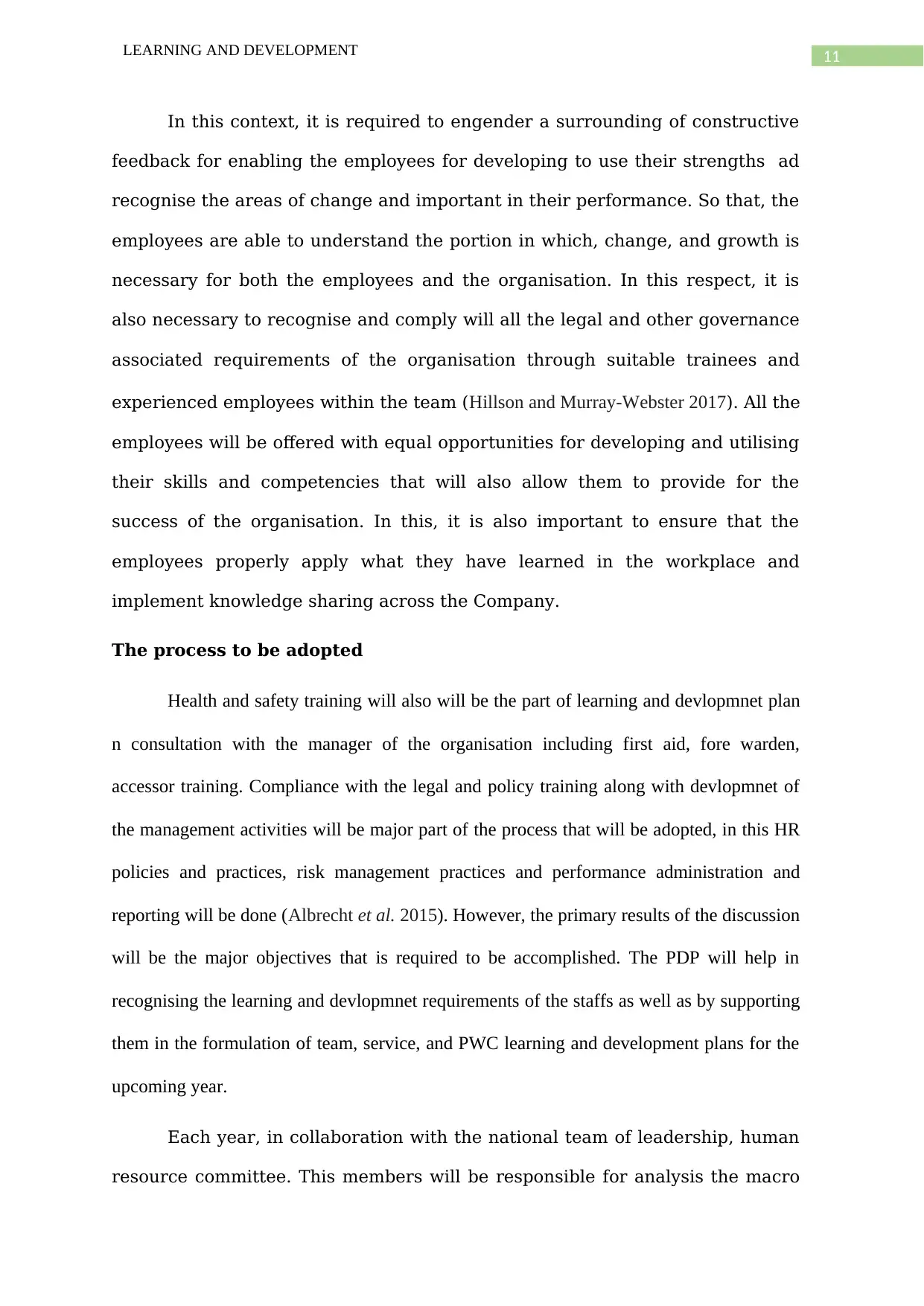
11LEARNING AND DEVELOPMENT
In this context, it is required to engender a surrounding of constructive
feedback for enabling the employees for developing to use their strengths ad
recognise the areas of change and important in their performance. So that, the
employees are able to understand the portion in which, change, and growth is
necessary for both the employees and the organisation. In this respect, it is
also necessary to recognise and comply will all the legal and other governance
associated requirements of the organisation through suitable trainees and
experienced employees within the team (Hillson and Murray-Webster 2017). All the
employees will be offered with equal opportunities for developing and utilising
their skills and competencies that will also allow them to provide for the
success of the organisation. In this, it is also important to ensure that the
employees properly apply what they have learned in the workplace and
implement knowledge sharing across the Company.
The process to be adopted
Health and safety training will also will be the part of learning and devlopmnet plan
n consultation with the manager of the organisation including first aid, fore warden,
accessor training. Compliance with the legal and policy training along with devlopmnet of
the management activities will be major part of the process that will be adopted, in this HR
policies and practices, risk management practices and performance administration and
reporting will be done (Albrecht et al. 2015). However, the primary results of the discussion
will be the major objectives that is required to be accomplished. The PDP will help in
recognising the learning and devlopmnet requirements of the staffs as well as by supporting
them in the formulation of team, service, and PWC learning and development plans for the
upcoming year.
Each year, in collaboration with the national team of leadership, human
resource committee. This members will be responsible for analysis the macro
In this context, it is required to engender a surrounding of constructive
feedback for enabling the employees for developing to use their strengths ad
recognise the areas of change and important in their performance. So that, the
employees are able to understand the portion in which, change, and growth is
necessary for both the employees and the organisation. In this respect, it is
also necessary to recognise and comply will all the legal and other governance
associated requirements of the organisation through suitable trainees and
experienced employees within the team (Hillson and Murray-Webster 2017). All the
employees will be offered with equal opportunities for developing and utilising
their skills and competencies that will also allow them to provide for the
success of the organisation. In this, it is also important to ensure that the
employees properly apply what they have learned in the workplace and
implement knowledge sharing across the Company.
The process to be adopted
Health and safety training will also will be the part of learning and devlopmnet plan
n consultation with the manager of the organisation including first aid, fore warden,
accessor training. Compliance with the legal and policy training along with devlopmnet of
the management activities will be major part of the process that will be adopted, in this HR
policies and practices, risk management practices and performance administration and
reporting will be done (Albrecht et al. 2015). However, the primary results of the discussion
will be the major objectives that is required to be accomplished. The PDP will help in
recognising the learning and devlopmnet requirements of the staffs as well as by supporting
them in the formulation of team, service, and PWC learning and development plans for the
upcoming year.
Each year, in collaboration with the national team of leadership, human
resource committee. This members will be responsible for analysis the macro
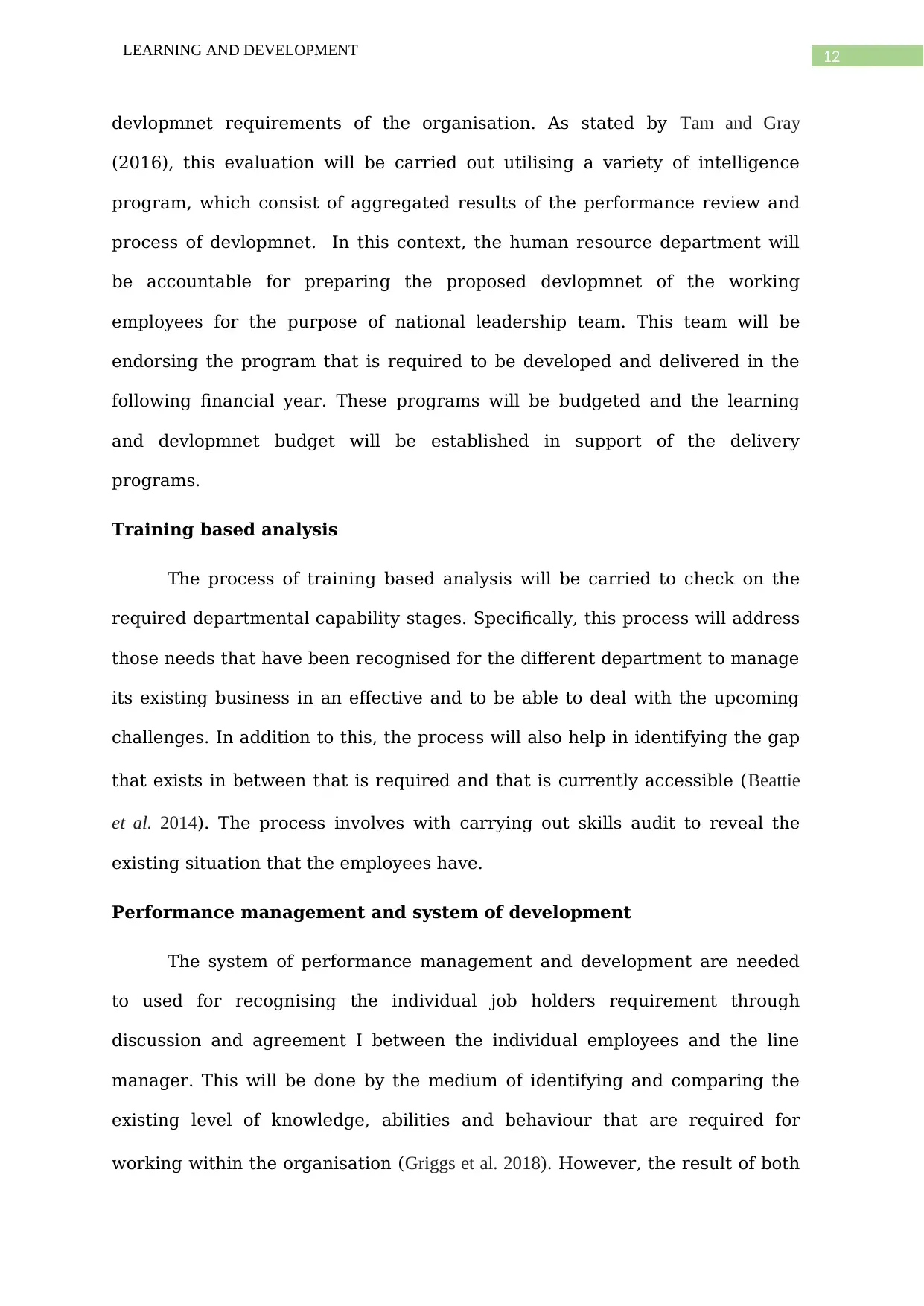
12LEARNING AND DEVELOPMENT
devlopmnet requirements of the organisation. As stated by Tam and Gray
(2016), this evaluation will be carried out utilising a variety of intelligence
program, which consist of aggregated results of the performance review and
process of devlopmnet. In this context, the human resource department will
be accountable for preparing the proposed devlopmnet of the working
employees for the purpose of national leadership team. This team will be
endorsing the program that is required to be developed and delivered in the
following financial year. These programs will be budgeted and the learning
and devlopmnet budget will be established in support of the delivery
programs.
Training based analysis
The process of training based analysis will be carried to check on the
required departmental capability stages. Specifically, this process will address
those needs that have been recognised for the different department to manage
its existing business in an effective and to be able to deal with the upcoming
challenges. In addition to this, the process will also help in identifying the gap
that exists in between that is required and that is currently accessible (Beattie
et al. 2014). The process involves with carrying out skills audit to reveal the
existing situation that the employees have.
Performance management and system of development
The system of performance management and development are needed
to used for recognising the individual job holders requirement through
discussion and agreement I between the individual employees and the line
manager. This will be done by the medium of identifying and comparing the
existing level of knowledge, abilities and behaviour that are required for
working within the organisation (Griggs et al. 2018). However, the result of both
devlopmnet requirements of the organisation. As stated by Tam and Gray
(2016), this evaluation will be carried out utilising a variety of intelligence
program, which consist of aggregated results of the performance review and
process of devlopmnet. In this context, the human resource department will
be accountable for preparing the proposed devlopmnet of the working
employees for the purpose of national leadership team. This team will be
endorsing the program that is required to be developed and delivered in the
following financial year. These programs will be budgeted and the learning
and devlopmnet budget will be established in support of the delivery
programs.
Training based analysis
The process of training based analysis will be carried to check on the
required departmental capability stages. Specifically, this process will address
those needs that have been recognised for the different department to manage
its existing business in an effective and to be able to deal with the upcoming
challenges. In addition to this, the process will also help in identifying the gap
that exists in between that is required and that is currently accessible (Beattie
et al. 2014). The process involves with carrying out skills audit to reveal the
existing situation that the employees have.
Performance management and system of development
The system of performance management and development are needed
to used for recognising the individual job holders requirement through
discussion and agreement I between the individual employees and the line
manager. This will be done by the medium of identifying and comparing the
existing level of knowledge, abilities and behaviour that are required for
working within the organisation (Griggs et al. 2018). However, the result of both
Paraphrase This Document
Need a fresh take? Get an instant paraphrase of this document with our AI Paraphraser
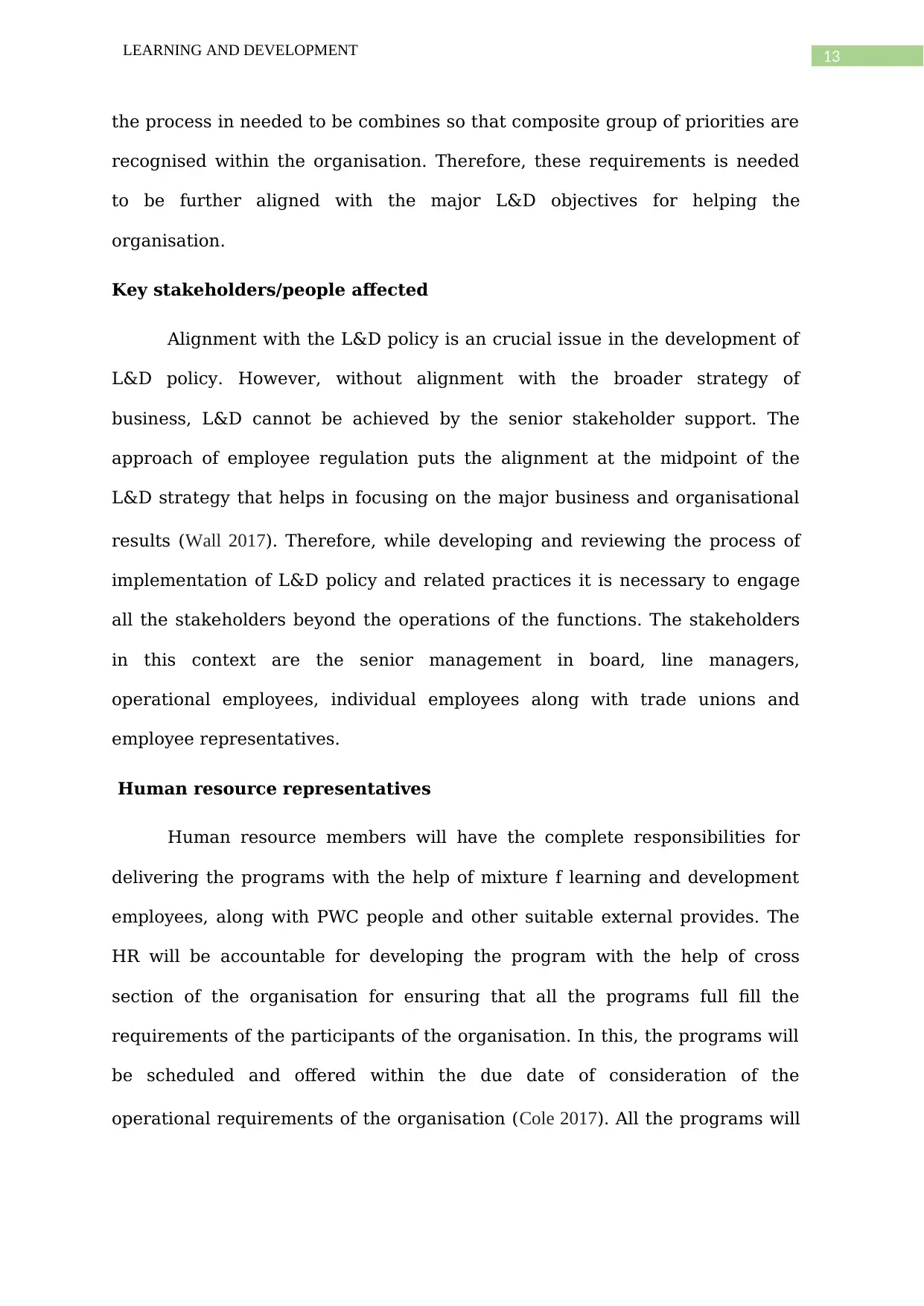
13LEARNING AND DEVELOPMENT
the process in needed to be combines so that composite group of priorities are
recognised within the organisation. Therefore, these requirements is needed
to be further aligned with the major L&D objectives for helping the
organisation.
Key stakeholders/people affected
Alignment with the L&D policy is an crucial issue in the development of
L&D policy. However, without alignment with the broader strategy of
business, L&D cannot be achieved by the senior stakeholder support. The
approach of employee regulation puts the alignment at the midpoint of the
L&D strategy that helps in focusing on the major business and organisational
results (Wall 2017). Therefore, while developing and reviewing the process of
implementation of L&D policy and related practices it is necessary to engage
all the stakeholders beyond the operations of the functions. The stakeholders
in this context are the senior management in board, line managers,
operational employees, individual employees along with trade unions and
employee representatives.
Human resource representatives
Human resource members will have the complete responsibilities for
delivering the programs with the help of mixture f learning and development
employees, along with PWC people and other suitable external provides. The
HR will be accountable for developing the program with the help of cross
section of the organisation for ensuring that all the programs full fill the
requirements of the participants of the organisation. In this, the programs will
be scheduled and offered within the due date of consideration of the
operational requirements of the organisation (Cole 2017). All the programs will
the process in needed to be combines so that composite group of priorities are
recognised within the organisation. Therefore, these requirements is needed
to be further aligned with the major L&D objectives for helping the
organisation.
Key stakeholders/people affected
Alignment with the L&D policy is an crucial issue in the development of
L&D policy. However, without alignment with the broader strategy of
business, L&D cannot be achieved by the senior stakeholder support. The
approach of employee regulation puts the alignment at the midpoint of the
L&D strategy that helps in focusing on the major business and organisational
results (Wall 2017). Therefore, while developing and reviewing the process of
implementation of L&D policy and related practices it is necessary to engage
all the stakeholders beyond the operations of the functions. The stakeholders
in this context are the senior management in board, line managers,
operational employees, individual employees along with trade unions and
employee representatives.
Human resource representatives
Human resource members will have the complete responsibilities for
delivering the programs with the help of mixture f learning and development
employees, along with PWC people and other suitable external provides. The
HR will be accountable for developing the program with the help of cross
section of the organisation for ensuring that all the programs full fill the
requirements of the participants of the organisation. In this, the programs will
be scheduled and offered within the due date of consideration of the
operational requirements of the organisation (Cole 2017). All the programs will
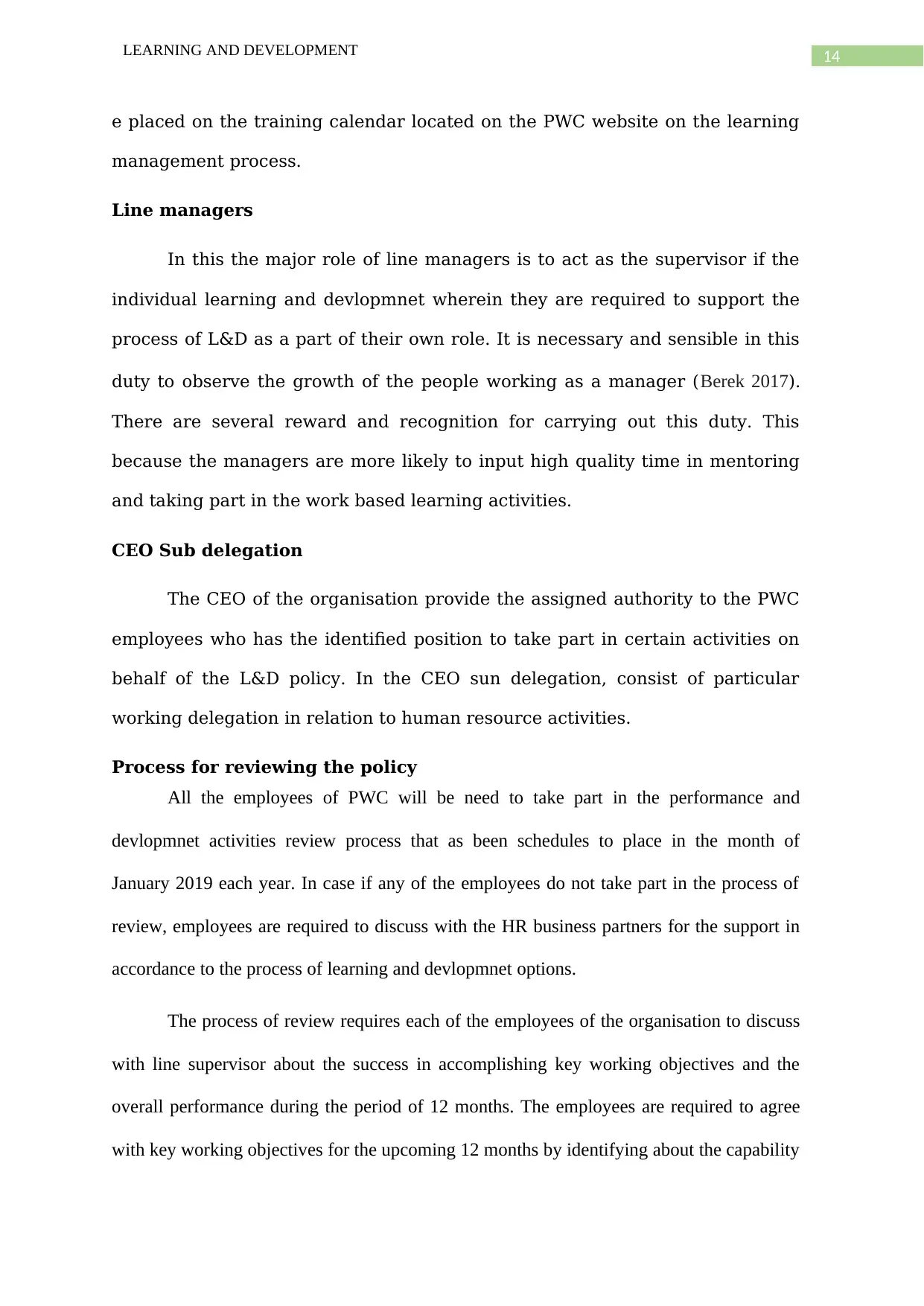
14LEARNING AND DEVELOPMENT
e placed on the training calendar located on the PWC website on the learning
management process.
Line managers
In this the major role of line managers is to act as the supervisor if the
individual learning and devlopmnet wherein they are required to support the
process of L&D as a part of their own role. It is necessary and sensible in this
duty to observe the growth of the people working as a manager (Berek 2017).
There are several reward and recognition for carrying out this duty. This
because the managers are more likely to input high quality time in mentoring
and taking part in the work based learning activities.
CEO Sub delegation
The CEO of the organisation provide the assigned authority to the PWC
employees who has the identified position to take part in certain activities on
behalf of the L&D policy. In the CEO sun delegation, consist of particular
working delegation in relation to human resource activities.
Process for reviewing the policy
All the employees of PWC will be need to take part in the performance and
devlopmnet activities review process that as been schedules to place in the month of
January 2019 each year. In case if any of the employees do not take part in the process of
review, employees are required to discuss with the HR business partners for the support in
accordance to the process of learning and devlopmnet options.
The process of review requires each of the employees of the organisation to discuss
with line supervisor about the success in accomplishing key working objectives and the
overall performance during the period of 12 months. The employees are required to agree
with key working objectives for the upcoming 12 months by identifying about the capability
e placed on the training calendar located on the PWC website on the learning
management process.
Line managers
In this the major role of line managers is to act as the supervisor if the
individual learning and devlopmnet wherein they are required to support the
process of L&D as a part of their own role. It is necessary and sensible in this
duty to observe the growth of the people working as a manager (Berek 2017).
There are several reward and recognition for carrying out this duty. This
because the managers are more likely to input high quality time in mentoring
and taking part in the work based learning activities.
CEO Sub delegation
The CEO of the organisation provide the assigned authority to the PWC
employees who has the identified position to take part in certain activities on
behalf of the L&D policy. In the CEO sun delegation, consist of particular
working delegation in relation to human resource activities.
Process for reviewing the policy
All the employees of PWC will be need to take part in the performance and
devlopmnet activities review process that as been schedules to place in the month of
January 2019 each year. In case if any of the employees do not take part in the process of
review, employees are required to discuss with the HR business partners for the support in
accordance to the process of learning and devlopmnet options.
The process of review requires each of the employees of the organisation to discuss
with line supervisor about the success in accomplishing key working objectives and the
overall performance during the period of 12 months. The employees are required to agree
with key working objectives for the upcoming 12 months by identifying about the capability
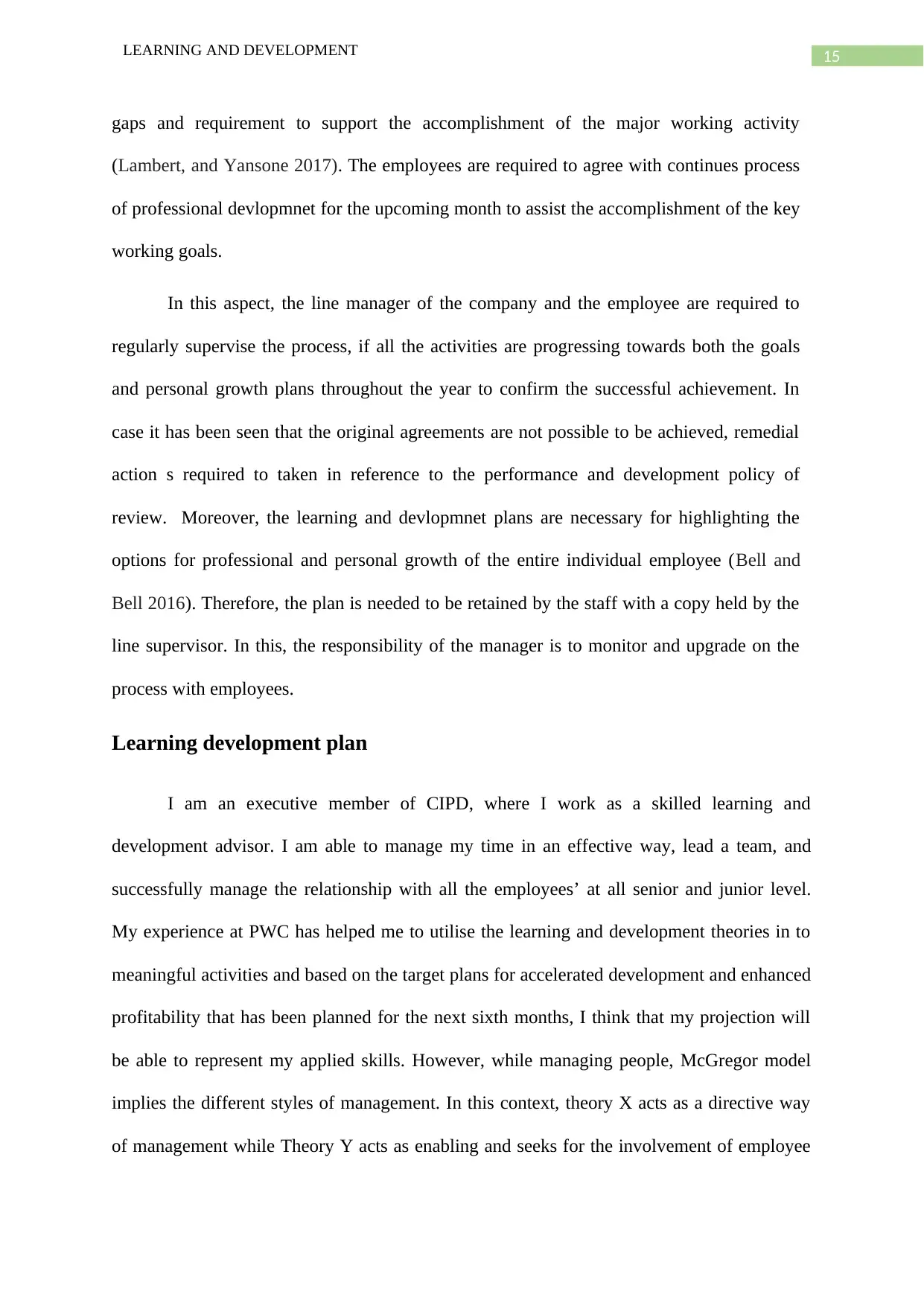
15LEARNING AND DEVELOPMENT
gaps and requirement to support the accomplishment of the major working activity
(Lambert, and Yansone 2017). The employees are required to agree with continues process
of professional devlopmnet for the upcoming month to assist the accomplishment of the key
working goals.
In this aspect, the line manager of the company and the employee are required to
regularly supervise the process, if all the activities are progressing towards both the goals
and personal growth plans throughout the year to confirm the successful achievement. In
case it has been seen that the original agreements are not possible to be achieved, remedial
action s required to taken in reference to the performance and development policy of
review. Moreover, the learning and devlopmnet plans are necessary for highlighting the
options for professional and personal growth of the entire individual employee (Bell and
Bell 2016). Therefore, the plan is needed to be retained by the staff with a copy held by the
line supervisor. In this, the responsibility of the manager is to monitor and upgrade on the
process with employees.
Learning development plan
I am an executive member of CIPD, where I work as a skilled learning and
development advisor. I am able to manage my time in an effective way, lead a team, and
successfully manage the relationship with all the employees’ at all senior and junior level.
My experience at PWC has helped me to utilise the learning and development theories in to
meaningful activities and based on the target plans for accelerated development and enhanced
profitability that has been planned for the next sixth months, I think that my projection will
be able to represent my applied skills. However, while managing people, McGregor model
implies the different styles of management. In this context, theory X acts as a directive way
of management while Theory Y acts as enabling and seeks for the involvement of employee
gaps and requirement to support the accomplishment of the major working activity
(Lambert, and Yansone 2017). The employees are required to agree with continues process
of professional devlopmnet for the upcoming month to assist the accomplishment of the key
working goals.
In this aspect, the line manager of the company and the employee are required to
regularly supervise the process, if all the activities are progressing towards both the goals
and personal growth plans throughout the year to confirm the successful achievement. In
case it has been seen that the original agreements are not possible to be achieved, remedial
action s required to taken in reference to the performance and development policy of
review. Moreover, the learning and devlopmnet plans are necessary for highlighting the
options for professional and personal growth of the entire individual employee (Bell and
Bell 2016). Therefore, the plan is needed to be retained by the staff with a copy held by the
line supervisor. In this, the responsibility of the manager is to monitor and upgrade on the
process with employees.
Learning development plan
I am an executive member of CIPD, where I work as a skilled learning and
development advisor. I am able to manage my time in an effective way, lead a team, and
successfully manage the relationship with all the employees’ at all senior and junior level.
My experience at PWC has helped me to utilise the learning and development theories in to
meaningful activities and based on the target plans for accelerated development and enhanced
profitability that has been planned for the next sixth months, I think that my projection will
be able to represent my applied skills. However, while managing people, McGregor model
implies the different styles of management. In this context, theory X acts as a directive way
of management while Theory Y acts as enabling and seeks for the involvement of employee
Secure Best Marks with AI Grader
Need help grading? Try our AI Grader for instant feedback on your assignments.
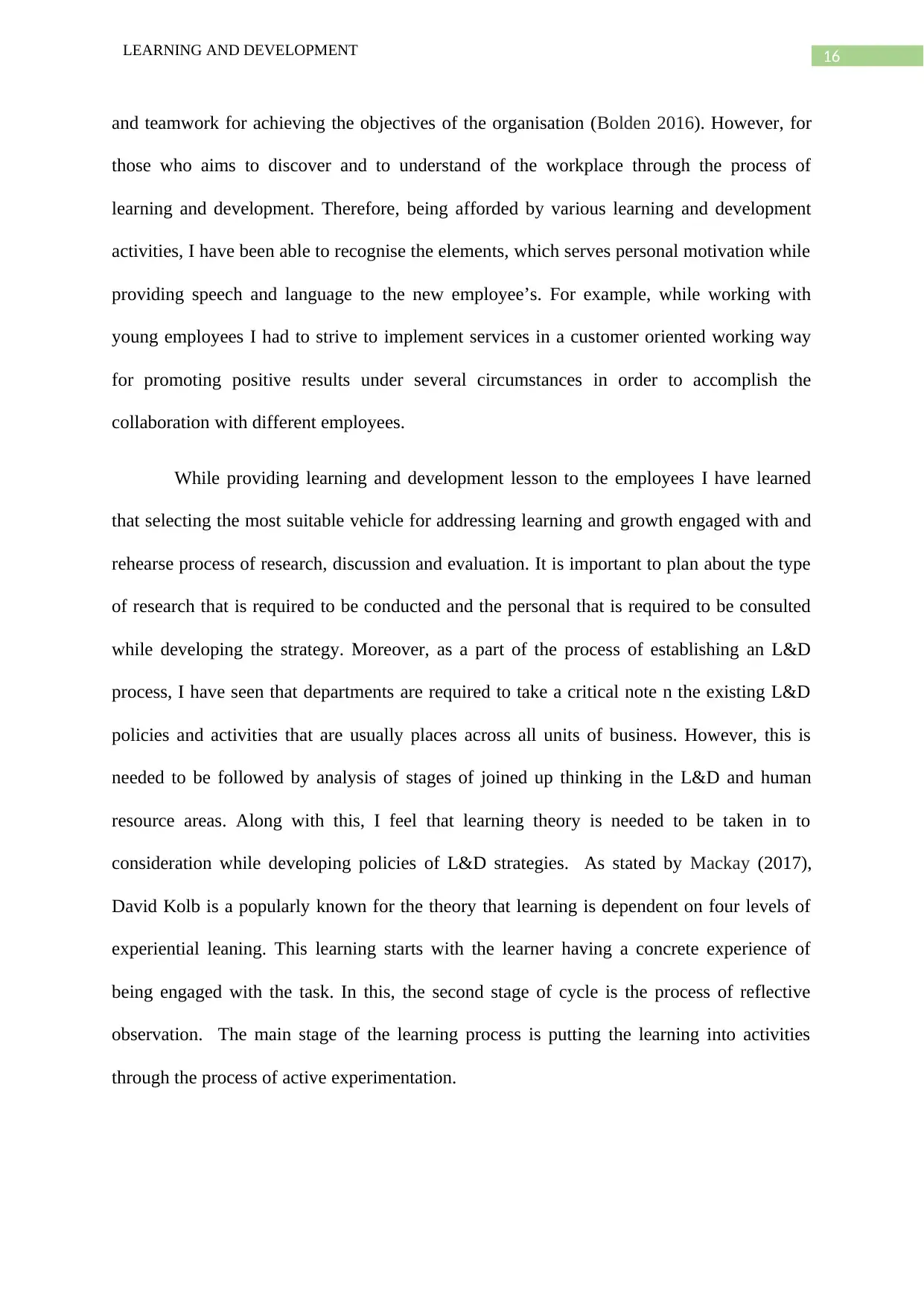
16LEARNING AND DEVELOPMENT
and teamwork for achieving the objectives of the organisation (Bolden 2016). However, for
those who aims to discover and to understand of the workplace through the process of
learning and development. Therefore, being afforded by various learning and development
activities, I have been able to recognise the elements, which serves personal motivation while
providing speech and language to the new employee’s. For example, while working with
young employees I had to strive to implement services in a customer oriented working way
for promoting positive results under several circumstances in order to accomplish the
collaboration with different employees.
While providing learning and development lesson to the employees I have learned
that selecting the most suitable vehicle for addressing learning and growth engaged with and
rehearse process of research, discussion and evaluation. It is important to plan about the type
of research that is required to be conducted and the personal that is required to be consulted
while developing the strategy. Moreover, as a part of the process of establishing an L&D
process, I have seen that departments are required to take a critical note n the existing L&D
policies and activities that are usually places across all units of business. However, this is
needed to be followed by analysis of stages of joined up thinking in the L&D and human
resource areas. Along with this, I feel that learning theory is needed to be taken in to
consideration while developing policies of L&D strategies. As stated by Mackay (2017),
David Kolb is a popularly known for the theory that learning is dependent on four levels of
experiential leaning. This learning starts with the learner having a concrete experience of
being engaged with the task. In this, the second stage of cycle is the process of reflective
observation. The main stage of the learning process is putting the learning into activities
through the process of active experimentation.
and teamwork for achieving the objectives of the organisation (Bolden 2016). However, for
those who aims to discover and to understand of the workplace through the process of
learning and development. Therefore, being afforded by various learning and development
activities, I have been able to recognise the elements, which serves personal motivation while
providing speech and language to the new employee’s. For example, while working with
young employees I had to strive to implement services in a customer oriented working way
for promoting positive results under several circumstances in order to accomplish the
collaboration with different employees.
While providing learning and development lesson to the employees I have learned
that selecting the most suitable vehicle for addressing learning and growth engaged with and
rehearse process of research, discussion and evaluation. It is important to plan about the type
of research that is required to be conducted and the personal that is required to be consulted
while developing the strategy. Moreover, as a part of the process of establishing an L&D
process, I have seen that departments are required to take a critical note n the existing L&D
policies and activities that are usually places across all units of business. However, this is
needed to be followed by analysis of stages of joined up thinking in the L&D and human
resource areas. Along with this, I feel that learning theory is needed to be taken in to
consideration while developing policies of L&D strategies. As stated by Mackay (2017),
David Kolb is a popularly known for the theory that learning is dependent on four levels of
experiential leaning. This learning starts with the learner having a concrete experience of
being engaged with the task. In this, the second stage of cycle is the process of reflective
observation. The main stage of the learning process is putting the learning into activities
through the process of active experimentation.
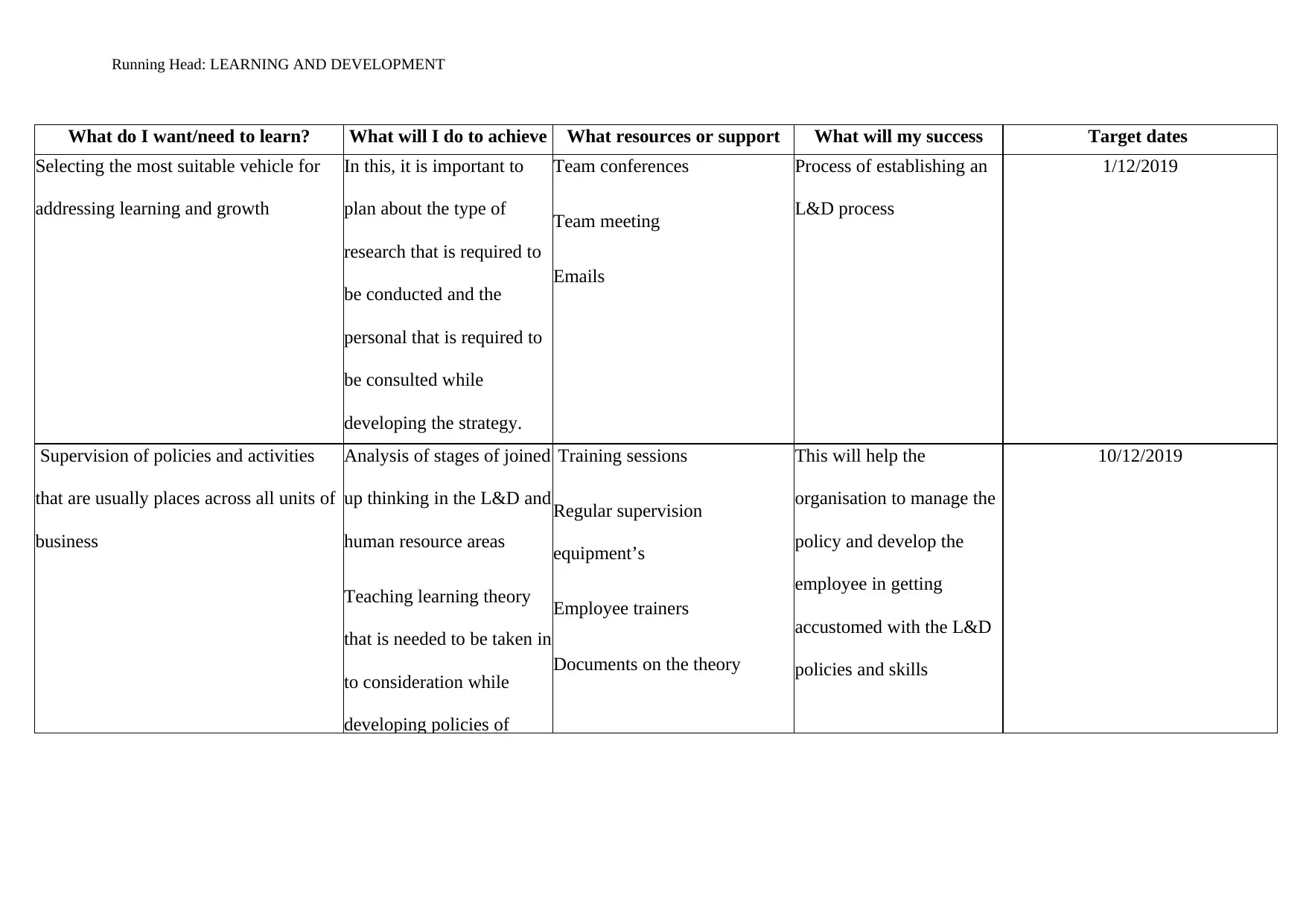
Running Head: LEARNING AND DEVELOPMENT
What do I want/need to learn? What will I do to achieve
this?
What resources or support
will I need?
What will my success
criteria be?
Target dates
completion
Selecting the most suitable vehicle for
addressing learning and growth
In this, it is important to
plan about the type of
research that is required to
be conducted and the
personal that is required to
be consulted while
developing the strategy.
Team conferences
Team meeting
Emails
Process of establishing an
L&D process
1/12/2019
Supervision of policies and activities
that are usually places across all units of
business
Analysis of stages of joined
up thinking in the L&D and
human resource areas
Teaching learning theory
that is needed to be taken in
to consideration while
developing policies of
Training sessions
Regular supervision
equipment’s
Employee trainers
Documents on the theory
This will help the
organisation to manage the
policy and develop the
employee in getting
accustomed with the L&D
policies and skills
10/12/2019
What do I want/need to learn? What will I do to achieve
this?
What resources or support
will I need?
What will my success
criteria be?
Target dates
completion
Selecting the most suitable vehicle for
addressing learning and growth
In this, it is important to
plan about the type of
research that is required to
be conducted and the
personal that is required to
be consulted while
developing the strategy.
Team conferences
Team meeting
Emails
Process of establishing an
L&D process
1/12/2019
Supervision of policies and activities
that are usually places across all units of
business
Analysis of stages of joined
up thinking in the L&D and
human resource areas
Teaching learning theory
that is needed to be taken in
to consideration while
developing policies of
Training sessions
Regular supervision
equipment’s
Employee trainers
Documents on the theory
This will help the
organisation to manage the
policy and develop the
employee in getting
accustomed with the L&D
policies and skills
10/12/2019
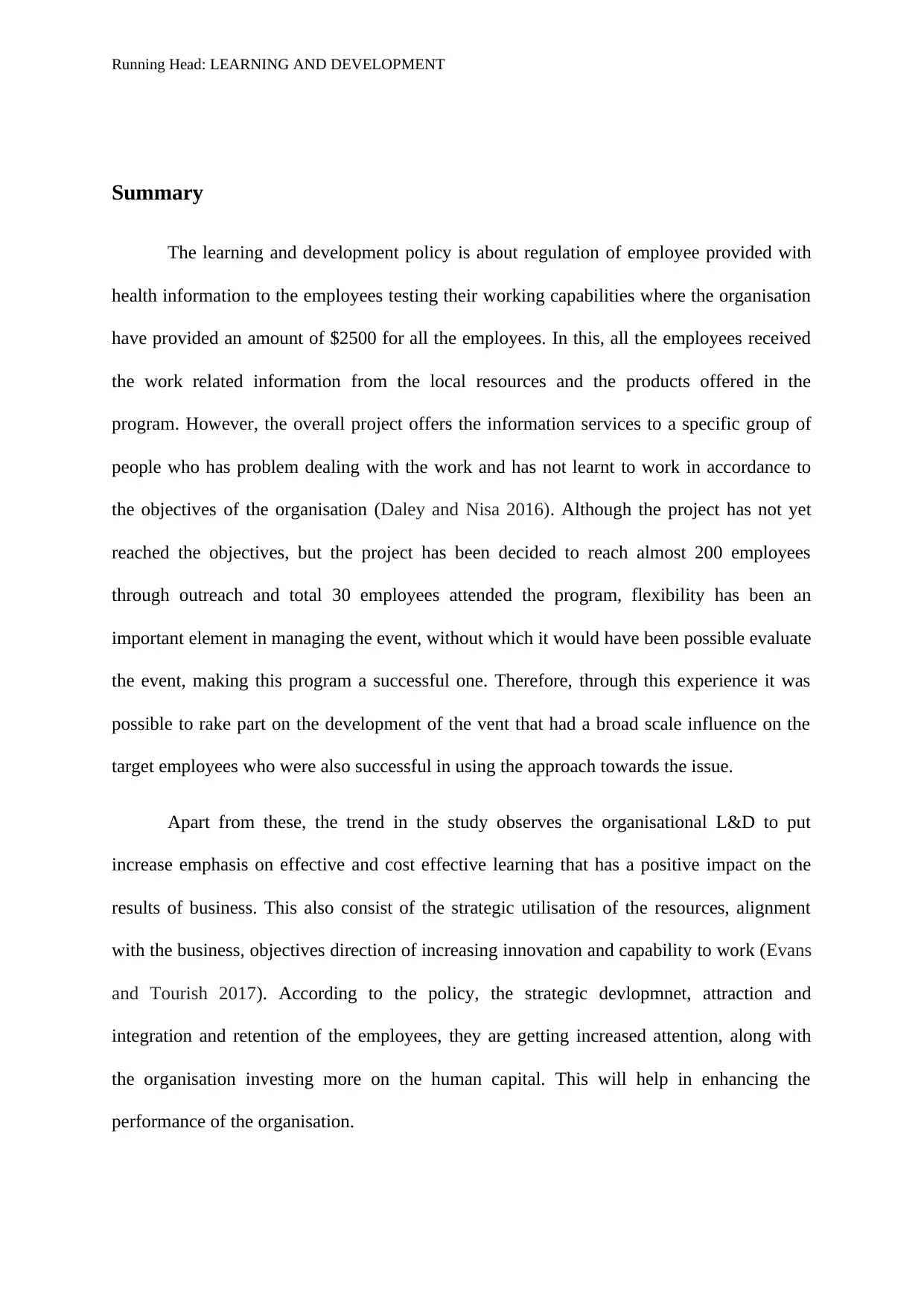
Running Head: LEARNING AND DEVELOPMENT
Summary
The learning and development policy is about regulation of employee provided with
health information to the employees testing their working capabilities where the organisation
have provided an amount of $2500 for all the employees. In this, all the employees received
the work related information from the local resources and the products offered in the
program. However, the overall project offers the information services to a specific group of
people who has problem dealing with the work and has not learnt to work in accordance to
the objectives of the organisation (Daley and Nisa 2016). Although the project has not yet
reached the objectives, but the project has been decided to reach almost 200 employees
through outreach and total 30 employees attended the program, flexibility has been an
important element in managing the event, without which it would have been possible evaluate
the event, making this program a successful one. Therefore, through this experience it was
possible to rake part on the development of the vent that had a broad scale influence on the
target employees who were also successful in using the approach towards the issue.
Apart from these, the trend in the study observes the organisational L&D to put
increase emphasis on effective and cost effective learning that has a positive impact on the
results of business. This also consist of the strategic utilisation of the resources, alignment
with the business, objectives direction of increasing innovation and capability to work (Evans
and Tourish 2017). According to the policy, the strategic devlopmnet, attraction and
integration and retention of the employees, they are getting increased attention, along with
the organisation investing more on the human capital. This will help in enhancing the
performance of the organisation.
Summary
The learning and development policy is about regulation of employee provided with
health information to the employees testing their working capabilities where the organisation
have provided an amount of $2500 for all the employees. In this, all the employees received
the work related information from the local resources and the products offered in the
program. However, the overall project offers the information services to a specific group of
people who has problem dealing with the work and has not learnt to work in accordance to
the objectives of the organisation (Daley and Nisa 2016). Although the project has not yet
reached the objectives, but the project has been decided to reach almost 200 employees
through outreach and total 30 employees attended the program, flexibility has been an
important element in managing the event, without which it would have been possible evaluate
the event, making this program a successful one. Therefore, through this experience it was
possible to rake part on the development of the vent that had a broad scale influence on the
target employees who were also successful in using the approach towards the issue.
Apart from these, the trend in the study observes the organisational L&D to put
increase emphasis on effective and cost effective learning that has a positive impact on the
results of business. This also consist of the strategic utilisation of the resources, alignment
with the business, objectives direction of increasing innovation and capability to work (Evans
and Tourish 2017). According to the policy, the strategic devlopmnet, attraction and
integration and retention of the employees, they are getting increased attention, along with
the organisation investing more on the human capital. This will help in enhancing the
performance of the organisation.
Paraphrase This Document
Need a fresh take? Get an instant paraphrase of this document with our AI Paraphraser
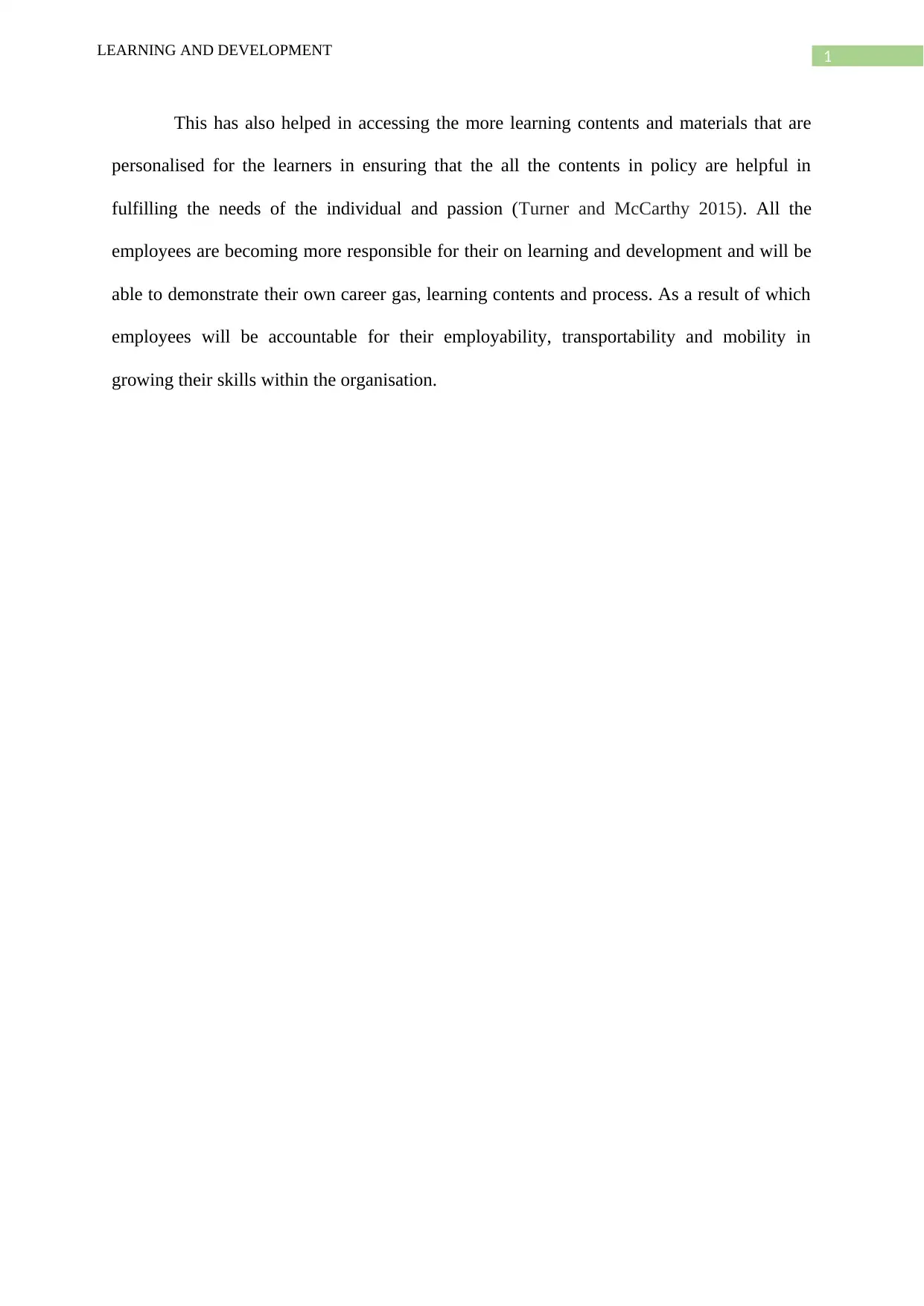
1LEARNING AND DEVELOPMENT
This has also helped in accessing the more learning contents and materials that are
personalised for the learners in ensuring that the all the contents in policy are helpful in
fulfilling the needs of the individual and passion (Turner and McCarthy 2015). All the
employees are becoming more responsible for their on learning and development and will be
able to demonstrate their own career gas, learning contents and process. As a result of which
employees will be accountable for their employability, transportability and mobility in
growing their skills within the organisation.
This has also helped in accessing the more learning contents and materials that are
personalised for the learners in ensuring that the all the contents in policy are helpful in
fulfilling the needs of the individual and passion (Turner and McCarthy 2015). All the
employees are becoming more responsible for their on learning and development and will be
able to demonstrate their own career gas, learning contents and process. As a result of which
employees will be accountable for their employability, transportability and mobility in
growing their skills within the organisation.
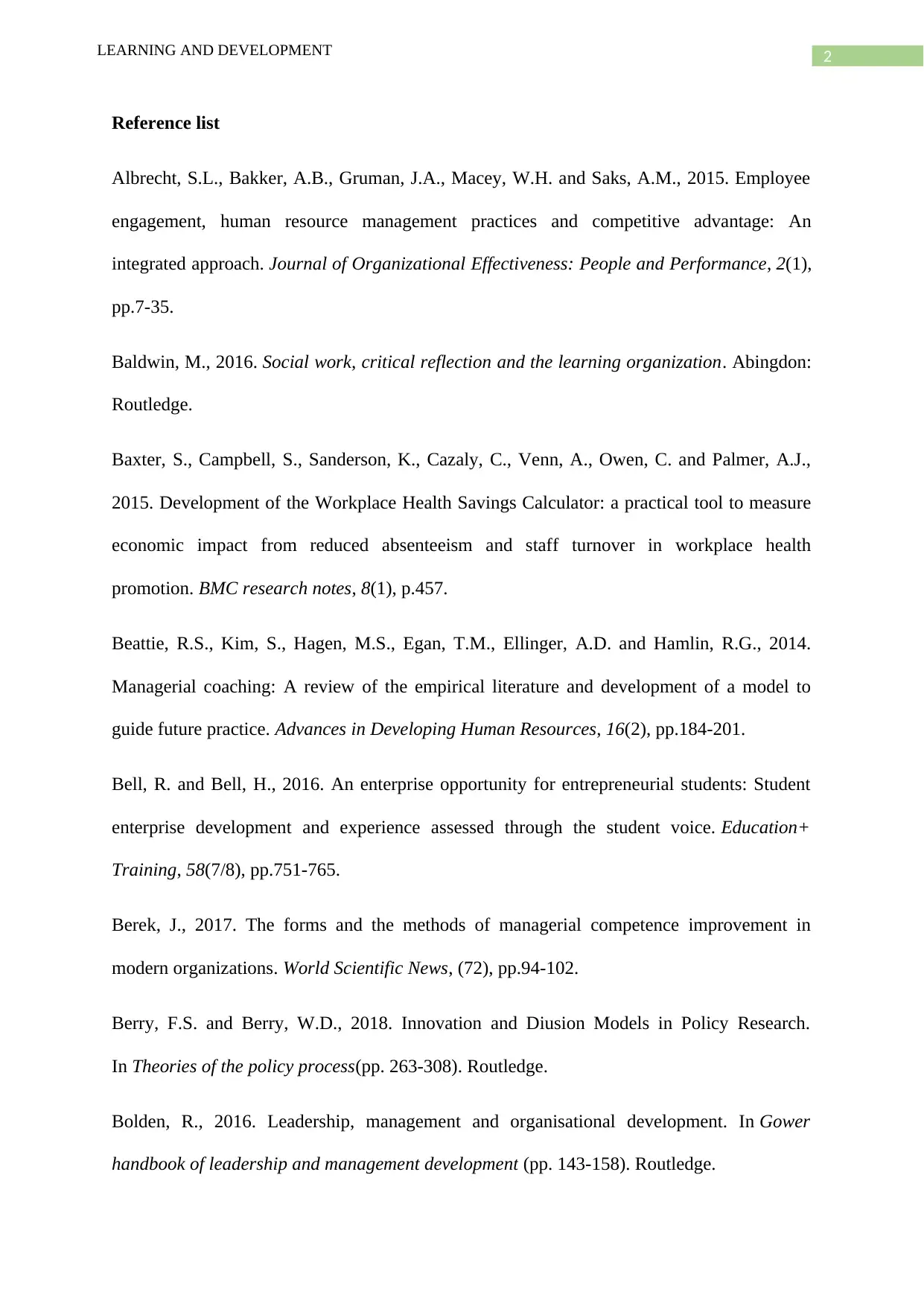
2LEARNING AND DEVELOPMENT
Reference list
Albrecht, S.L., Bakker, A.B., Gruman, J.A., Macey, W.H. and Saks, A.M., 2015. Employee
engagement, human resource management practices and competitive advantage: An
integrated approach. Journal of Organizational Effectiveness: People and Performance, 2(1),
pp.7-35.
Baldwin, M., 2016. Social work, critical reflection and the learning organization. Abingdon:
Routledge.
Baxter, S., Campbell, S., Sanderson, K., Cazaly, C., Venn, A., Owen, C. and Palmer, A.J.,
2015. Development of the Workplace Health Savings Calculator: a practical tool to measure
economic impact from reduced absenteeism and staff turnover in workplace health
promotion. BMC research notes, 8(1), p.457.
Beattie, R.S., Kim, S., Hagen, M.S., Egan, T.M., Ellinger, A.D. and Hamlin, R.G., 2014.
Managerial coaching: A review of the empirical literature and development of a model to
guide future practice. Advances in Developing Human Resources, 16(2), pp.184-201.
Bell, R. and Bell, H., 2016. An enterprise opportunity for entrepreneurial students: Student
enterprise development and experience assessed through the student voice. Education+
Training, 58(7/8), pp.751-765.
Berek, J., 2017. The forms and the methods of managerial competence improvement in
modern organizations. World Scientific News, (72), pp.94-102.
Berry, F.S. and Berry, W.D., 2018. Innovation and Diusion Models in Policy Research.
In Theories of the policy process(pp. 263-308). Routledge.
Bolden, R., 2016. Leadership, management and organisational development. In Gower
handbook of leadership and management development (pp. 143-158). Routledge.
Reference list
Albrecht, S.L., Bakker, A.B., Gruman, J.A., Macey, W.H. and Saks, A.M., 2015. Employee
engagement, human resource management practices and competitive advantage: An
integrated approach. Journal of Organizational Effectiveness: People and Performance, 2(1),
pp.7-35.
Baldwin, M., 2016. Social work, critical reflection and the learning organization. Abingdon:
Routledge.
Baxter, S., Campbell, S., Sanderson, K., Cazaly, C., Venn, A., Owen, C. and Palmer, A.J.,
2015. Development of the Workplace Health Savings Calculator: a practical tool to measure
economic impact from reduced absenteeism and staff turnover in workplace health
promotion. BMC research notes, 8(1), p.457.
Beattie, R.S., Kim, S., Hagen, M.S., Egan, T.M., Ellinger, A.D. and Hamlin, R.G., 2014.
Managerial coaching: A review of the empirical literature and development of a model to
guide future practice. Advances in Developing Human Resources, 16(2), pp.184-201.
Bell, R. and Bell, H., 2016. An enterprise opportunity for entrepreneurial students: Student
enterprise development and experience assessed through the student voice. Education+
Training, 58(7/8), pp.751-765.
Berek, J., 2017. The forms and the methods of managerial competence improvement in
modern organizations. World Scientific News, (72), pp.94-102.
Berry, F.S. and Berry, W.D., 2018. Innovation and Diusion Models in Policy Research.
In Theories of the policy process(pp. 263-308). Routledge.
Bolden, R., 2016. Leadership, management and organisational development. In Gower
handbook of leadership and management development (pp. 143-158). Routledge.
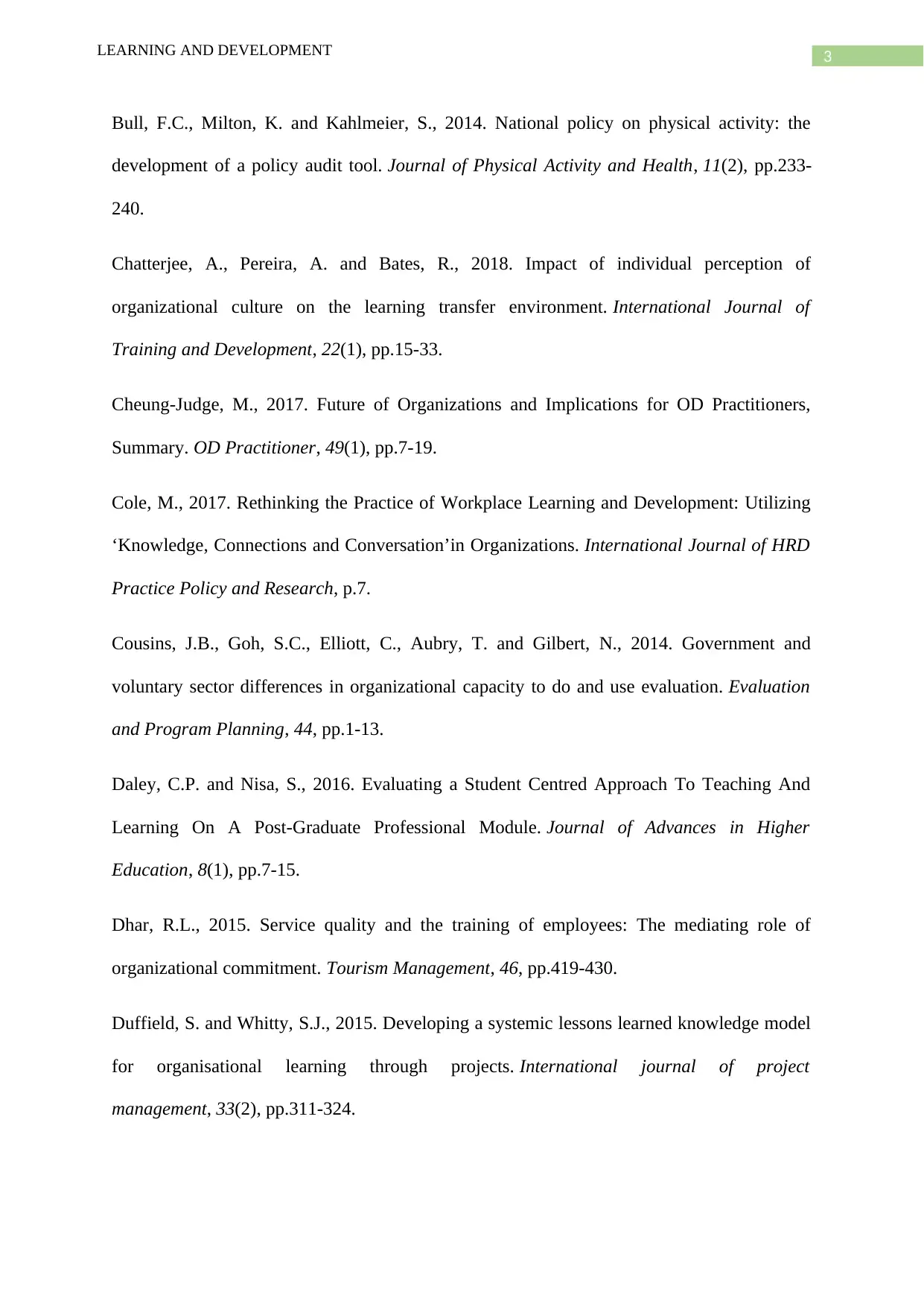
3LEARNING AND DEVELOPMENT
Bull, F.C., Milton, K. and Kahlmeier, S., 2014. National policy on physical activity: the
development of a policy audit tool. Journal of Physical Activity and Health, 11(2), pp.233-
240.
Chatterjee, A., Pereira, A. and Bates, R., 2018. Impact of individual perception of
organizational culture on the learning transfer environment. International Journal of
Training and Development, 22(1), pp.15-33.
Cheung-Judge, M., 2017. Future of Organizations and Implications for OD Practitioners,
Summary. OD Practitioner, 49(1), pp.7-19.
Cole, M., 2017. Rethinking the Practice of Workplace Learning and Development: Utilizing
‘Knowledge, Connections and Conversation’in Organizations. International Journal of HRD
Practice Policy and Research, p.7.
Cousins, J.B., Goh, S.C., Elliott, C., Aubry, T. and Gilbert, N., 2014. Government and
voluntary sector differences in organizational capacity to do and use evaluation. Evaluation
and Program Planning, 44, pp.1-13.
Daley, C.P. and Nisa, S., 2016. Evaluating a Student Centred Approach To Teaching And
Learning On A Post-Graduate Professional Module. Journal of Advances in Higher
Education, 8(1), pp.7-15.
Dhar, R.L., 2015. Service quality and the training of employees: The mediating role of
organizational commitment. Tourism Management, 46, pp.419-430.
Duffield, S. and Whitty, S.J., 2015. Developing a systemic lessons learned knowledge model
for organisational learning through projects. International journal of project
management, 33(2), pp.311-324.
Bull, F.C., Milton, K. and Kahlmeier, S., 2014. National policy on physical activity: the
development of a policy audit tool. Journal of Physical Activity and Health, 11(2), pp.233-
240.
Chatterjee, A., Pereira, A. and Bates, R., 2018. Impact of individual perception of
organizational culture on the learning transfer environment. International Journal of
Training and Development, 22(1), pp.15-33.
Cheung-Judge, M., 2017. Future of Organizations and Implications for OD Practitioners,
Summary. OD Practitioner, 49(1), pp.7-19.
Cole, M., 2017. Rethinking the Practice of Workplace Learning and Development: Utilizing
‘Knowledge, Connections and Conversation’in Organizations. International Journal of HRD
Practice Policy and Research, p.7.
Cousins, J.B., Goh, S.C., Elliott, C., Aubry, T. and Gilbert, N., 2014. Government and
voluntary sector differences in organizational capacity to do and use evaluation. Evaluation
and Program Planning, 44, pp.1-13.
Daley, C.P. and Nisa, S., 2016. Evaluating a Student Centred Approach To Teaching And
Learning On A Post-Graduate Professional Module. Journal of Advances in Higher
Education, 8(1), pp.7-15.
Dhar, R.L., 2015. Service quality and the training of employees: The mediating role of
organizational commitment. Tourism Management, 46, pp.419-430.
Duffield, S. and Whitty, S.J., 2015. Developing a systemic lessons learned knowledge model
for organisational learning through projects. International journal of project
management, 33(2), pp.311-324.
Secure Best Marks with AI Grader
Need help grading? Try our AI Grader for instant feedback on your assignments.
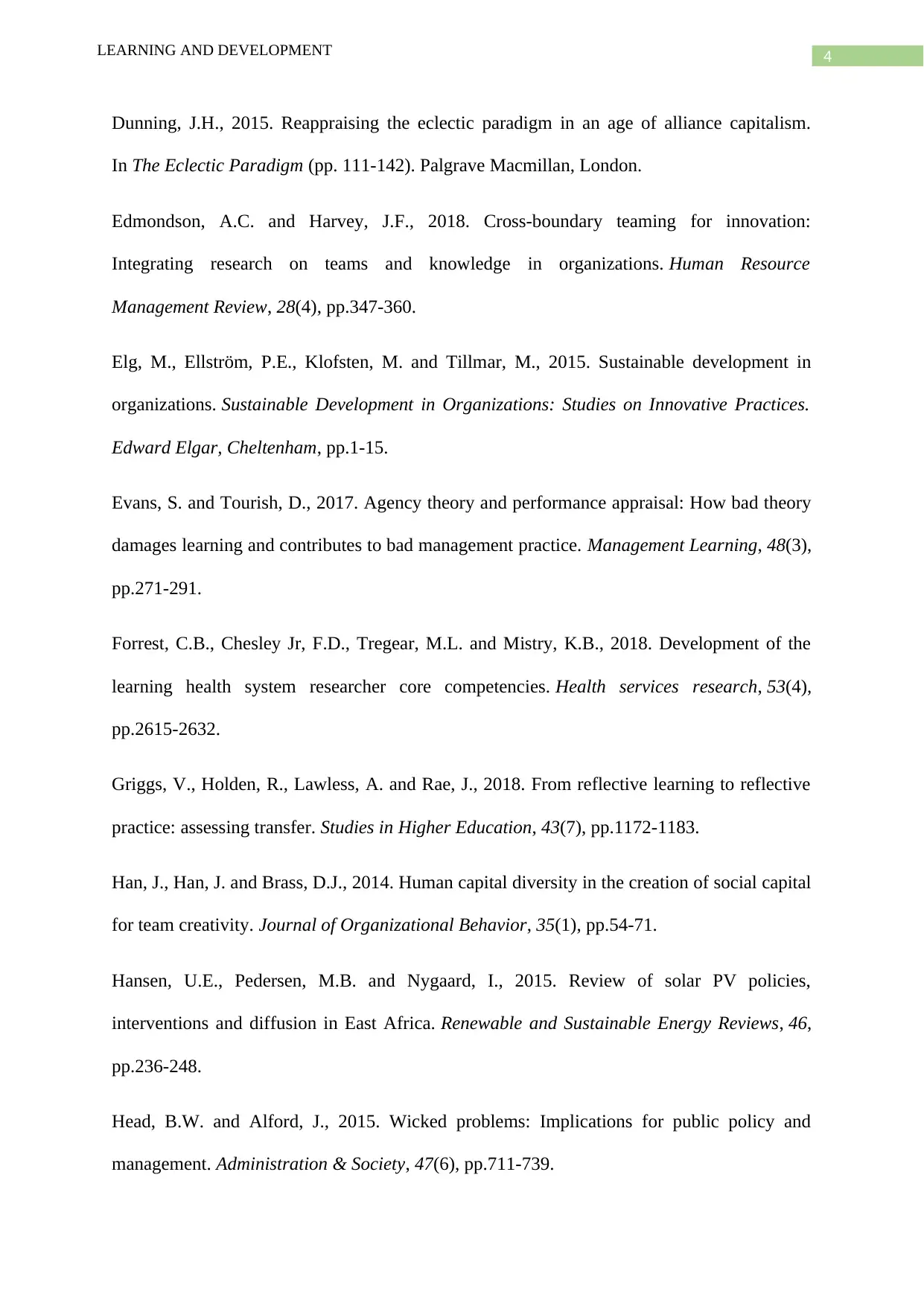
4LEARNING AND DEVELOPMENT
Dunning, J.H., 2015. Reappraising the eclectic paradigm in an age of alliance capitalism.
In The Eclectic Paradigm (pp. 111-142). Palgrave Macmillan, London.
Edmondson, A.C. and Harvey, J.F., 2018. Cross-boundary teaming for innovation:
Integrating research on teams and knowledge in organizations. Human Resource
Management Review, 28(4), pp.347-360.
Elg, M., Ellström, P.E., Klofsten, M. and Tillmar, M., 2015. Sustainable development in
organizations. Sustainable Development in Organizations: Studies on Innovative Practices.
Edward Elgar, Cheltenham, pp.1-15.
Evans, S. and Tourish, D., 2017. Agency theory and performance appraisal: How bad theory
damages learning and contributes to bad management practice. Management Learning, 48(3),
pp.271-291.
Forrest, C.B., Chesley Jr, F.D., Tregear, M.L. and Mistry, K.B., 2018. Development of the
learning health system researcher core competencies. Health services research, 53(4),
pp.2615-2632.
Griggs, V., Holden, R., Lawless, A. and Rae, J., 2018. From reflective learning to reflective
practice: assessing transfer. Studies in Higher Education, 43(7), pp.1172-1183.
Han, J., Han, J. and Brass, D.J., 2014. Human capital diversity in the creation of social capital
for team creativity. Journal of Organizational Behavior, 35(1), pp.54-71.
Hansen, U.E., Pedersen, M.B. and Nygaard, I., 2015. Review of solar PV policies,
interventions and diffusion in East Africa. Renewable and Sustainable Energy Reviews, 46,
pp.236-248.
Head, B.W. and Alford, J., 2015. Wicked problems: Implications for public policy and
management. Administration & Society, 47(6), pp.711-739.
Dunning, J.H., 2015. Reappraising the eclectic paradigm in an age of alliance capitalism.
In The Eclectic Paradigm (pp. 111-142). Palgrave Macmillan, London.
Edmondson, A.C. and Harvey, J.F., 2018. Cross-boundary teaming for innovation:
Integrating research on teams and knowledge in organizations. Human Resource
Management Review, 28(4), pp.347-360.
Elg, M., Ellström, P.E., Klofsten, M. and Tillmar, M., 2015. Sustainable development in
organizations. Sustainable Development in Organizations: Studies on Innovative Practices.
Edward Elgar, Cheltenham, pp.1-15.
Evans, S. and Tourish, D., 2017. Agency theory and performance appraisal: How bad theory
damages learning and contributes to bad management practice. Management Learning, 48(3),
pp.271-291.
Forrest, C.B., Chesley Jr, F.D., Tregear, M.L. and Mistry, K.B., 2018. Development of the
learning health system researcher core competencies. Health services research, 53(4),
pp.2615-2632.
Griggs, V., Holden, R., Lawless, A. and Rae, J., 2018. From reflective learning to reflective
practice: assessing transfer. Studies in Higher Education, 43(7), pp.1172-1183.
Han, J., Han, J. and Brass, D.J., 2014. Human capital diversity in the creation of social capital
for team creativity. Journal of Organizational Behavior, 35(1), pp.54-71.
Hansen, U.E., Pedersen, M.B. and Nygaard, I., 2015. Review of solar PV policies,
interventions and diffusion in East Africa. Renewable and Sustainable Energy Reviews, 46,
pp.236-248.
Head, B.W. and Alford, J., 2015. Wicked problems: Implications for public policy and
management. Administration & Society, 47(6), pp.711-739.
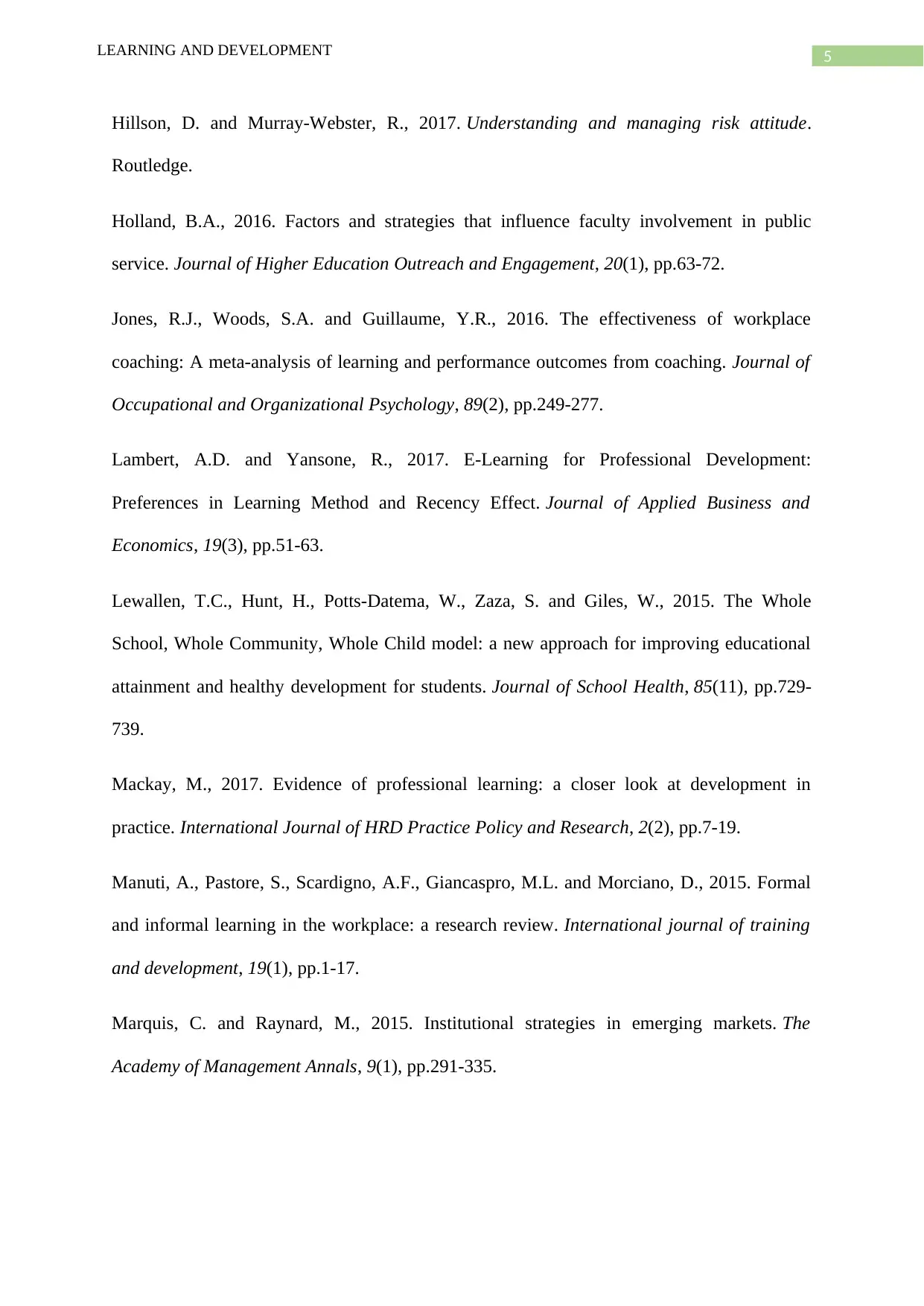
5LEARNING AND DEVELOPMENT
Hillson, D. and Murray-Webster, R., 2017. Understanding and managing risk attitude.
Routledge.
Holland, B.A., 2016. Factors and strategies that influence faculty involvement in public
service. Journal of Higher Education Outreach and Engagement, 20(1), pp.63-72.
Jones, R.J., Woods, S.A. and Guillaume, Y.R., 2016. The effectiveness of workplace
coaching: A meta‐analysis of learning and performance outcomes from coaching. Journal of
Occupational and Organizational Psychology, 89(2), pp.249-277.
Lambert, A.D. and Yansone, R., 2017. E-Learning for Professional Development:
Preferences in Learning Method and Recency Effect. Journal of Applied Business and
Economics, 19(3), pp.51-63.
Lewallen, T.C., Hunt, H., Potts‐Datema, W., Zaza, S. and Giles, W., 2015. The Whole
School, Whole Community, Whole Child model: a new approach for improving educational
attainment and healthy development for students. Journal of School Health, 85(11), pp.729-
739.
Mackay, M., 2017. Evidence of professional learning: a closer look at development in
practice. International Journal of HRD Practice Policy and Research, 2(2), pp.7-19.
Manuti, A., Pastore, S., Scardigno, A.F., Giancaspro, M.L. and Morciano, D., 2015. Formal
and informal learning in the workplace: a research review. International journal of training
and development, 19(1), pp.1-17.
Marquis, C. and Raynard, M., 2015. Institutional strategies in emerging markets. The
Academy of Management Annals, 9(1), pp.291-335.
Hillson, D. and Murray-Webster, R., 2017. Understanding and managing risk attitude.
Routledge.
Holland, B.A., 2016. Factors and strategies that influence faculty involvement in public
service. Journal of Higher Education Outreach and Engagement, 20(1), pp.63-72.
Jones, R.J., Woods, S.A. and Guillaume, Y.R., 2016. The effectiveness of workplace
coaching: A meta‐analysis of learning and performance outcomes from coaching. Journal of
Occupational and Organizational Psychology, 89(2), pp.249-277.
Lambert, A.D. and Yansone, R., 2017. E-Learning for Professional Development:
Preferences in Learning Method and Recency Effect. Journal of Applied Business and
Economics, 19(3), pp.51-63.
Lewallen, T.C., Hunt, H., Potts‐Datema, W., Zaza, S. and Giles, W., 2015. The Whole
School, Whole Community, Whole Child model: a new approach for improving educational
attainment and healthy development for students. Journal of School Health, 85(11), pp.729-
739.
Mackay, M., 2017. Evidence of professional learning: a closer look at development in
practice. International Journal of HRD Practice Policy and Research, 2(2), pp.7-19.
Manuti, A., Pastore, S., Scardigno, A.F., Giancaspro, M.L. and Morciano, D., 2015. Formal
and informal learning in the workplace: a research review. International journal of training
and development, 19(1), pp.1-17.
Marquis, C. and Raynard, M., 2015. Institutional strategies in emerging markets. The
Academy of Management Annals, 9(1), pp.291-335.
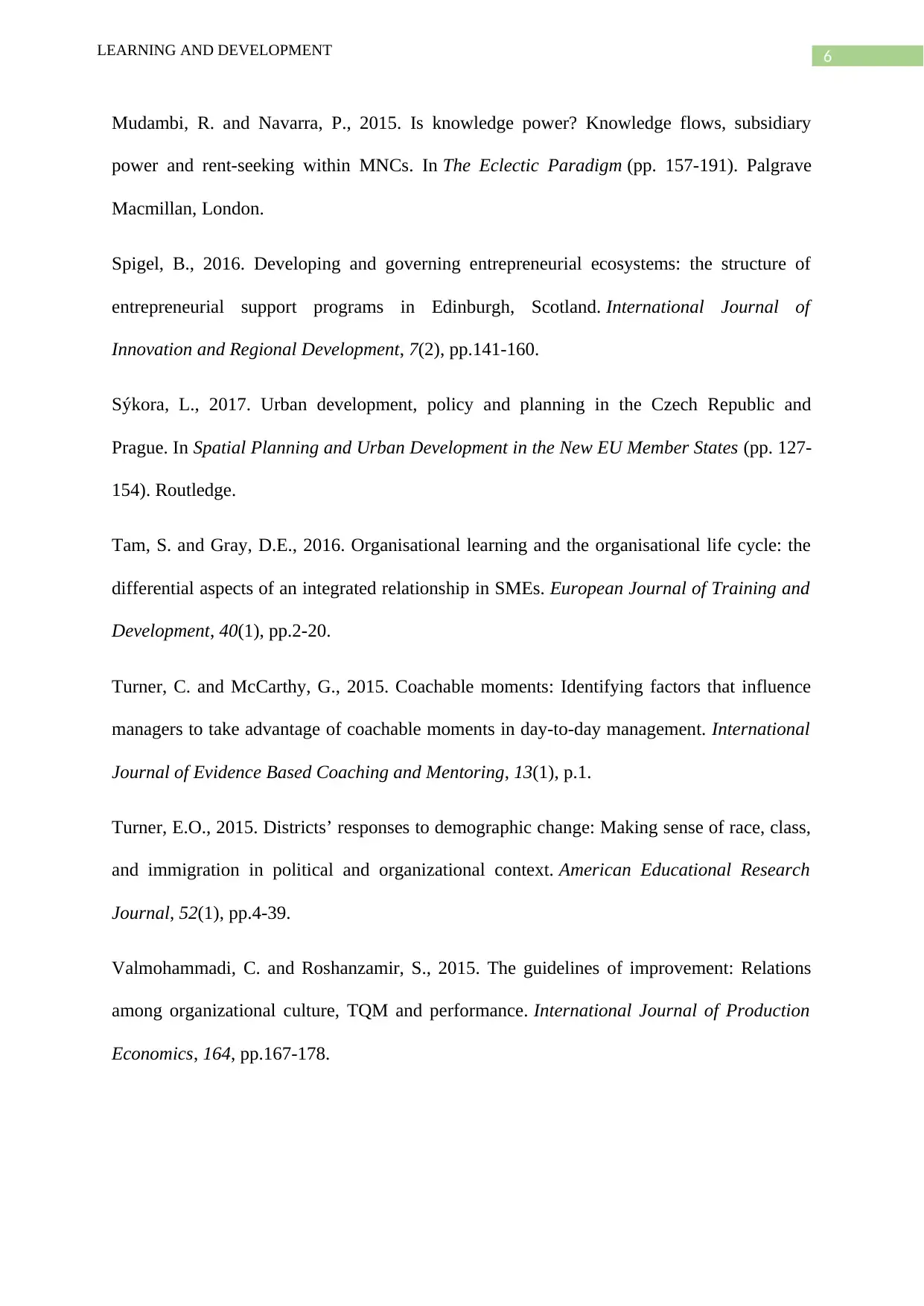
6LEARNING AND DEVELOPMENT
Mudambi, R. and Navarra, P., 2015. Is knowledge power? Knowledge flows, subsidiary
power and rent-seeking within MNCs. In The Eclectic Paradigm (pp. 157-191). Palgrave
Macmillan, London.
Spigel, B., 2016. Developing and governing entrepreneurial ecosystems: the structure of
entrepreneurial support programs in Edinburgh, Scotland. International Journal of
Innovation and Regional Development, 7(2), pp.141-160.
Sýkora, L., 2017. Urban development, policy and planning in the Czech Republic and
Prague. In Spatial Planning and Urban Development in the New EU Member States (pp. 127-
154). Routledge.
Tam, S. and Gray, D.E., 2016. Organisational learning and the organisational life cycle: the
differential aspects of an integrated relationship in SMEs. European Journal of Training and
Development, 40(1), pp.2-20.
Turner, C. and McCarthy, G., 2015. Coachable moments: Identifying factors that influence
managers to take advantage of coachable moments in day-to-day management. International
Journal of Evidence Based Coaching and Mentoring, 13(1), p.1.
Turner, E.O., 2015. Districts’ responses to demographic change: Making sense of race, class,
and immigration in political and organizational context. American Educational Research
Journal, 52(1), pp.4-39.
Valmohammadi, C. and Roshanzamir, S., 2015. The guidelines of improvement: Relations
among organizational culture, TQM and performance. International Journal of Production
Economics, 164, pp.167-178.
Mudambi, R. and Navarra, P., 2015. Is knowledge power? Knowledge flows, subsidiary
power and rent-seeking within MNCs. In The Eclectic Paradigm (pp. 157-191). Palgrave
Macmillan, London.
Spigel, B., 2016. Developing and governing entrepreneurial ecosystems: the structure of
entrepreneurial support programs in Edinburgh, Scotland. International Journal of
Innovation and Regional Development, 7(2), pp.141-160.
Sýkora, L., 2017. Urban development, policy and planning in the Czech Republic and
Prague. In Spatial Planning and Urban Development in the New EU Member States (pp. 127-
154). Routledge.
Tam, S. and Gray, D.E., 2016. Organisational learning and the organisational life cycle: the
differential aspects of an integrated relationship in SMEs. European Journal of Training and
Development, 40(1), pp.2-20.
Turner, C. and McCarthy, G., 2015. Coachable moments: Identifying factors that influence
managers to take advantage of coachable moments in day-to-day management. International
Journal of Evidence Based Coaching and Mentoring, 13(1), p.1.
Turner, E.O., 2015. Districts’ responses to demographic change: Making sense of race, class,
and immigration in political and organizational context. American Educational Research
Journal, 52(1), pp.4-39.
Valmohammadi, C. and Roshanzamir, S., 2015. The guidelines of improvement: Relations
among organizational culture, TQM and performance. International Journal of Production
Economics, 164, pp.167-178.
Paraphrase This Document
Need a fresh take? Get an instant paraphrase of this document with our AI Paraphraser
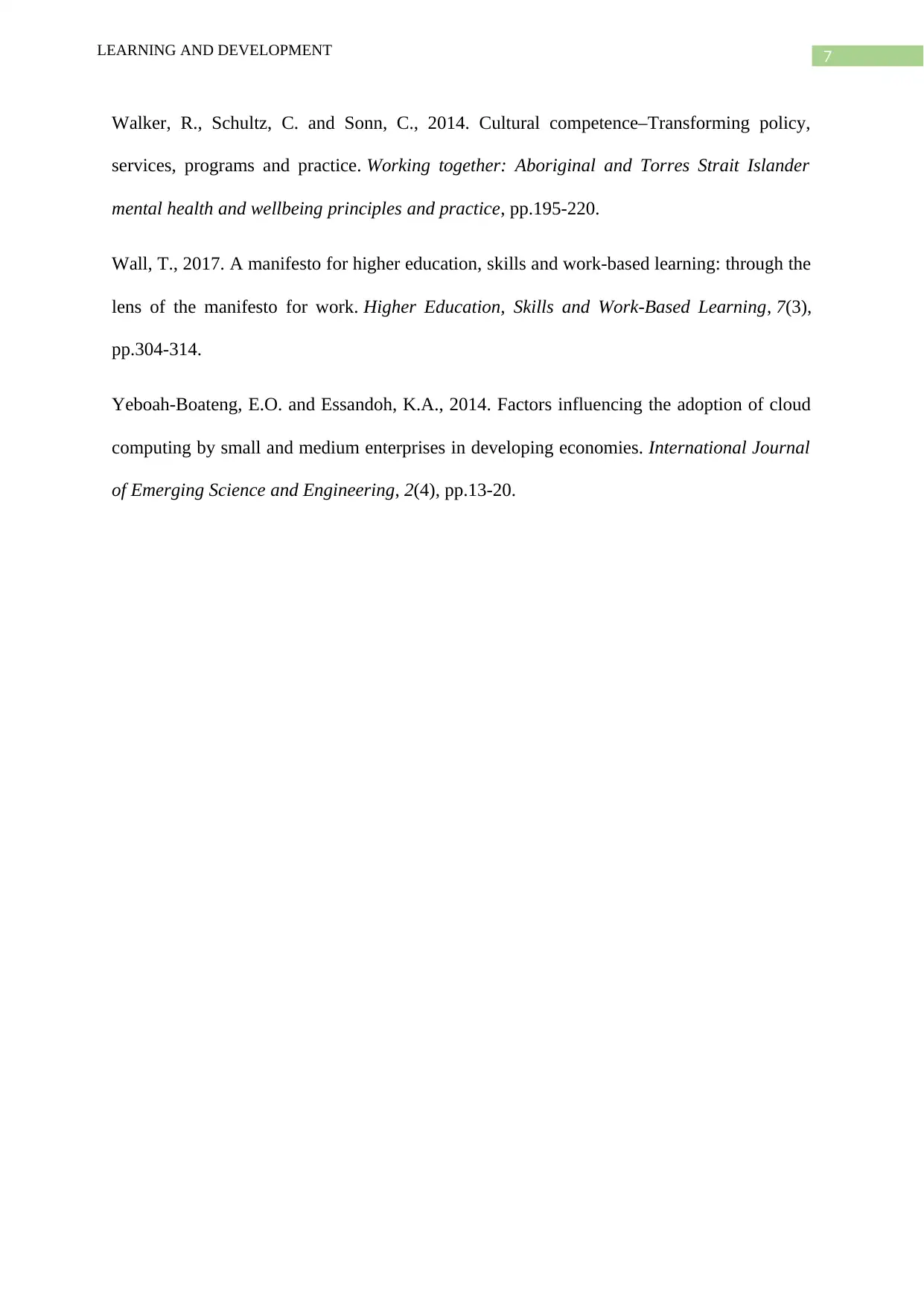
7LEARNING AND DEVELOPMENT
Walker, R., Schultz, C. and Sonn, C., 2014. Cultural competence–Transforming policy,
services, programs and practice. Working together: Aboriginal and Torres Strait Islander
mental health and wellbeing principles and practice, pp.195-220.
Wall, T., 2017. A manifesto for higher education, skills and work-based learning: through the
lens of the manifesto for work. Higher Education, Skills and Work-Based Learning, 7(3),
pp.304-314.
Yeboah-Boateng, E.O. and Essandoh, K.A., 2014. Factors influencing the adoption of cloud
computing by small and medium enterprises in developing economies. International Journal
of Emerging Science and Engineering, 2(4), pp.13-20.
Walker, R., Schultz, C. and Sonn, C., 2014. Cultural competence–Transforming policy,
services, programs and practice. Working together: Aboriginal and Torres Strait Islander
mental health and wellbeing principles and practice, pp.195-220.
Wall, T., 2017. A manifesto for higher education, skills and work-based learning: through the
lens of the manifesto for work. Higher Education, Skills and Work-Based Learning, 7(3),
pp.304-314.
Yeboah-Boateng, E.O. and Essandoh, K.A., 2014. Factors influencing the adoption of cloud
computing by small and medium enterprises in developing economies. International Journal
of Emerging Science and Engineering, 2(4), pp.13-20.
1 out of 26
Related Documents
Your All-in-One AI-Powered Toolkit for Academic Success.
+13062052269
info@desklib.com
Available 24*7 on WhatsApp / Email
![[object Object]](/_next/static/media/star-bottom.7253800d.svg)
Unlock your academic potential
© 2024 | Zucol Services PVT LTD | All rights reserved.





